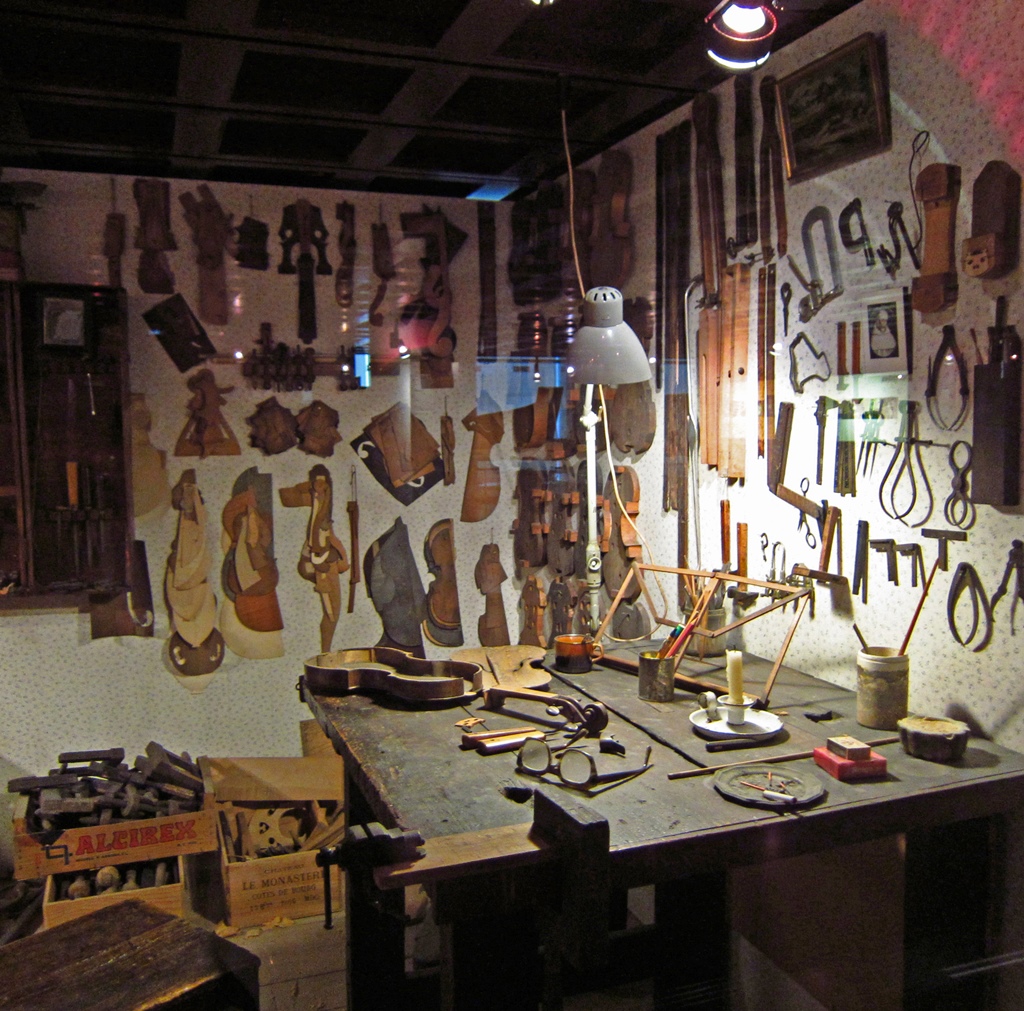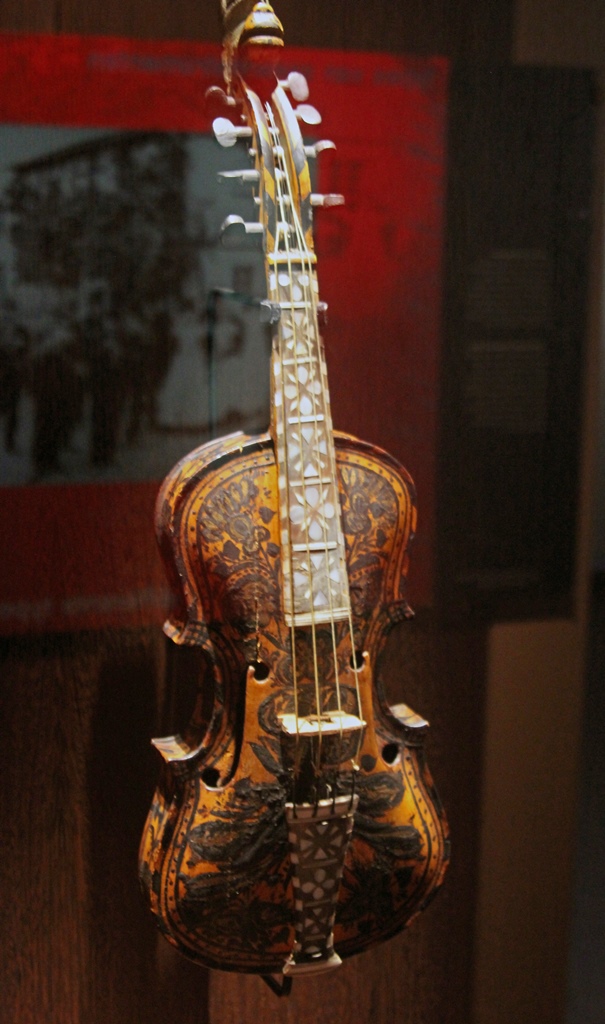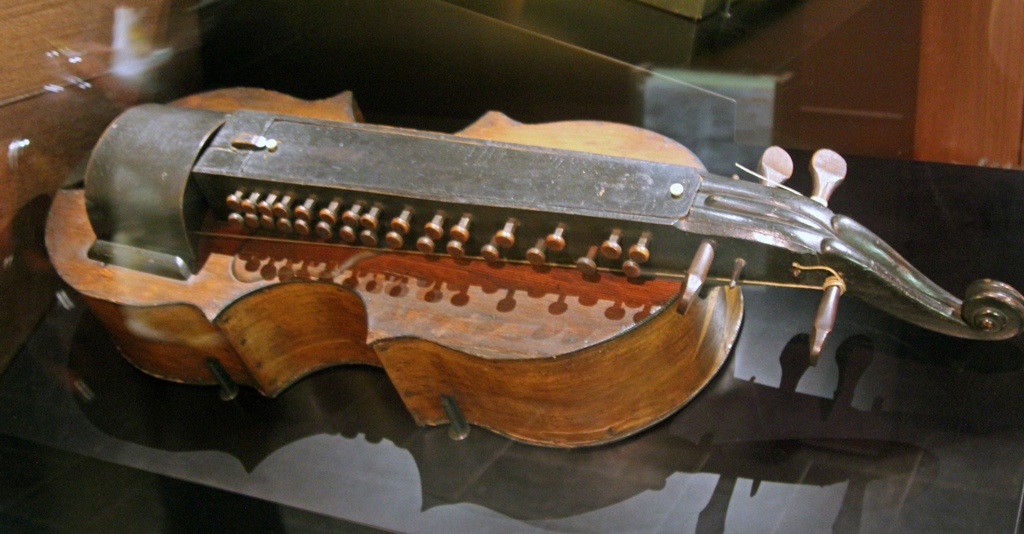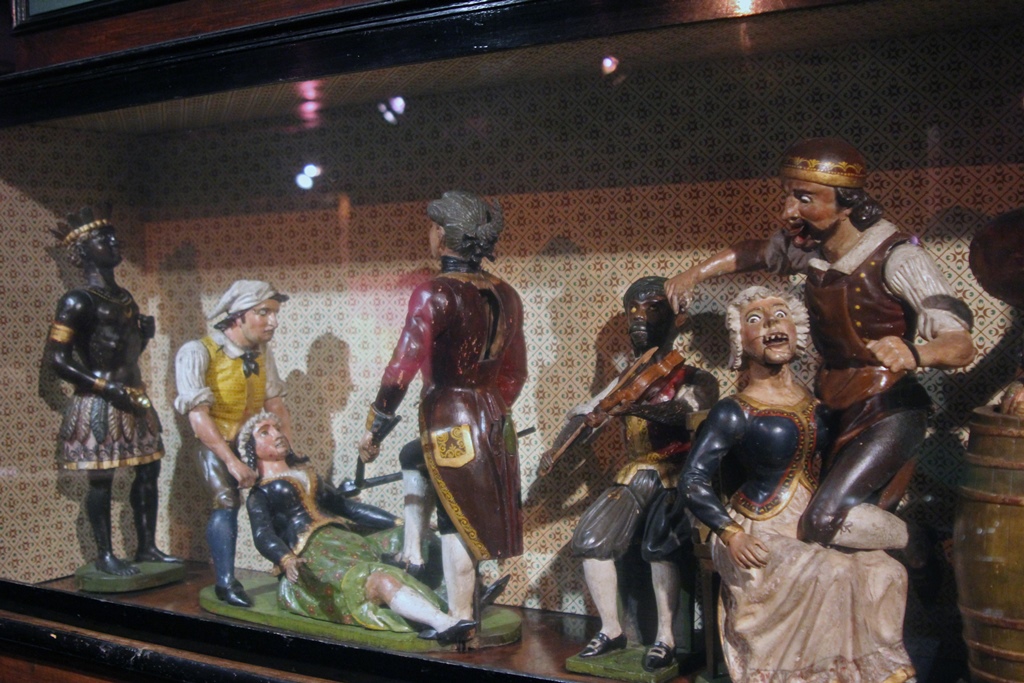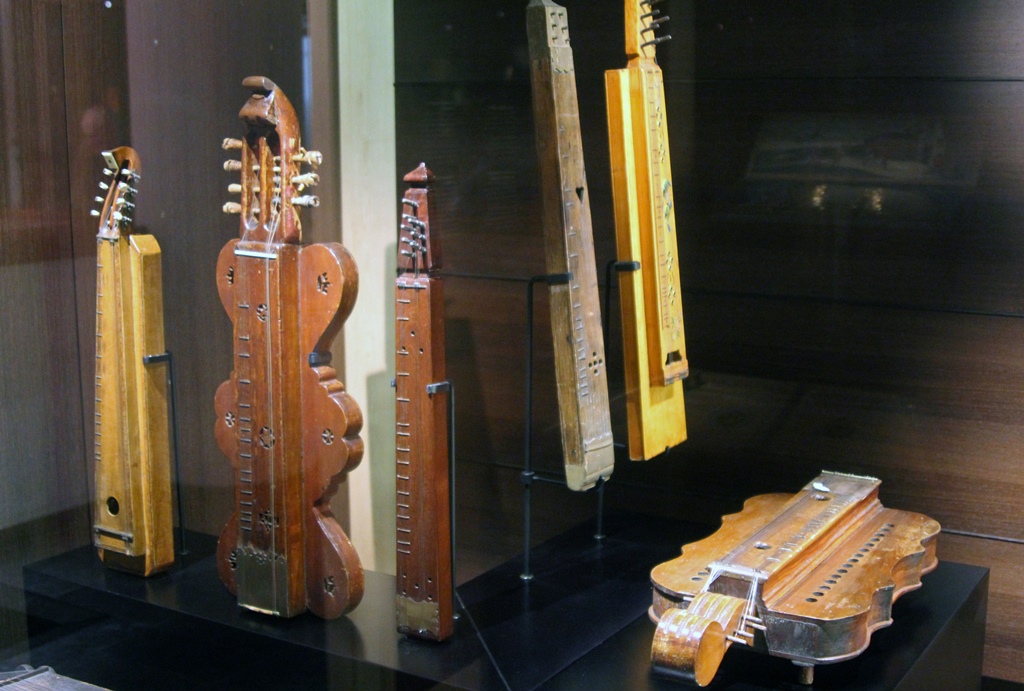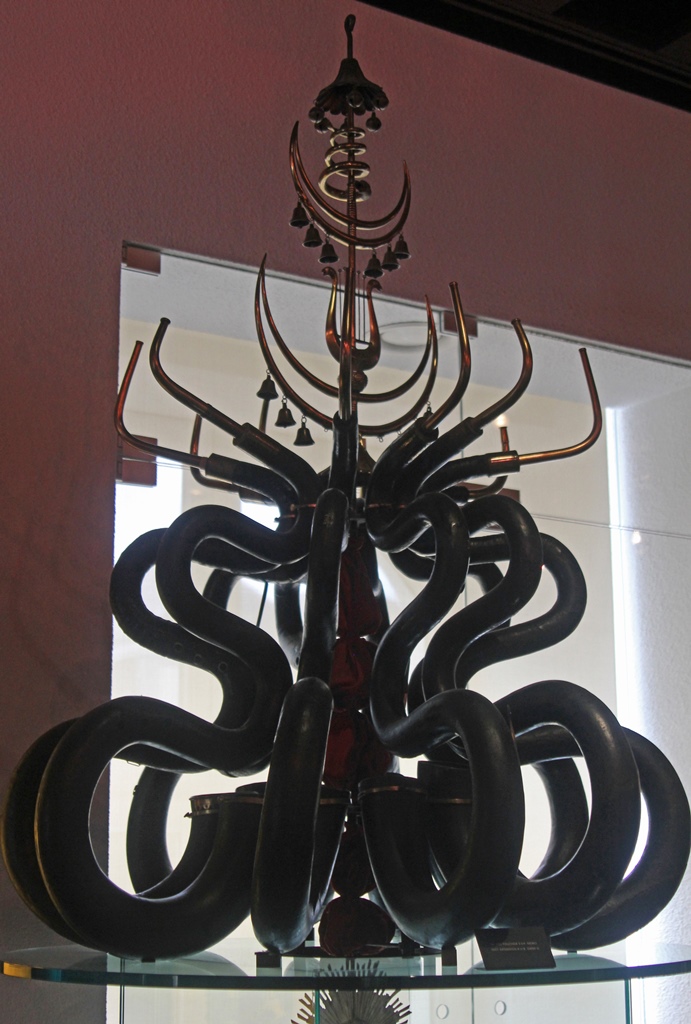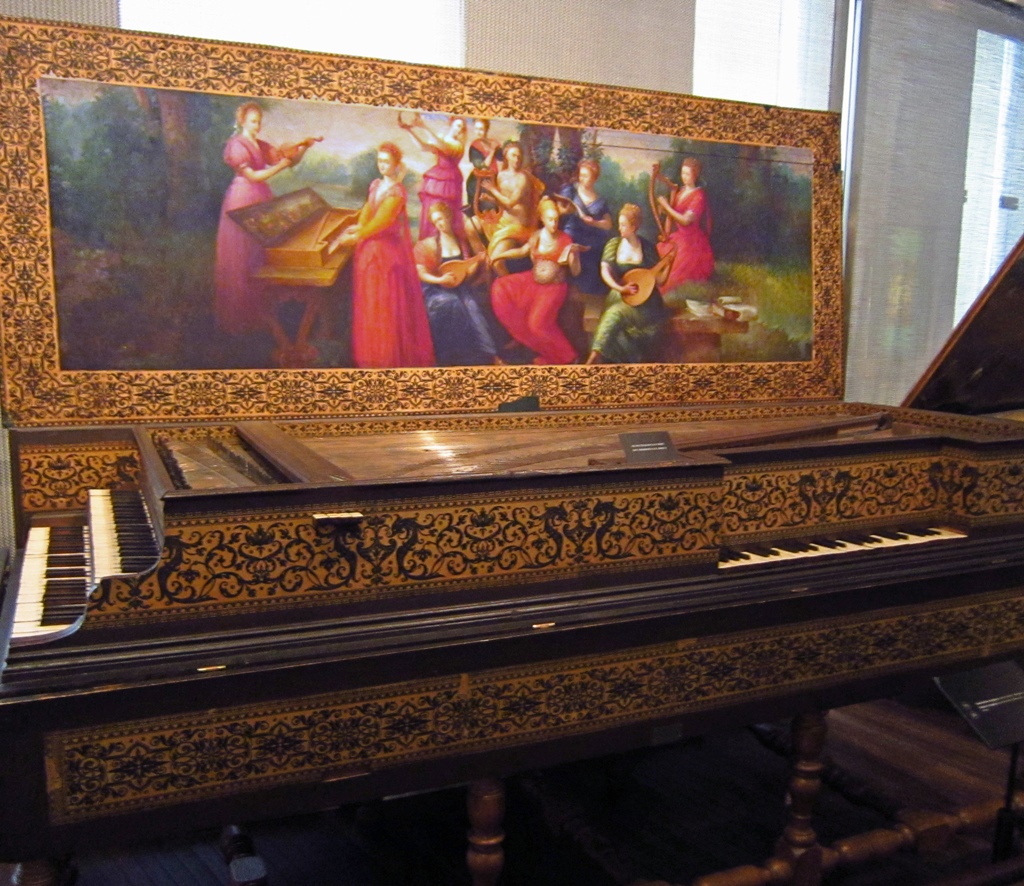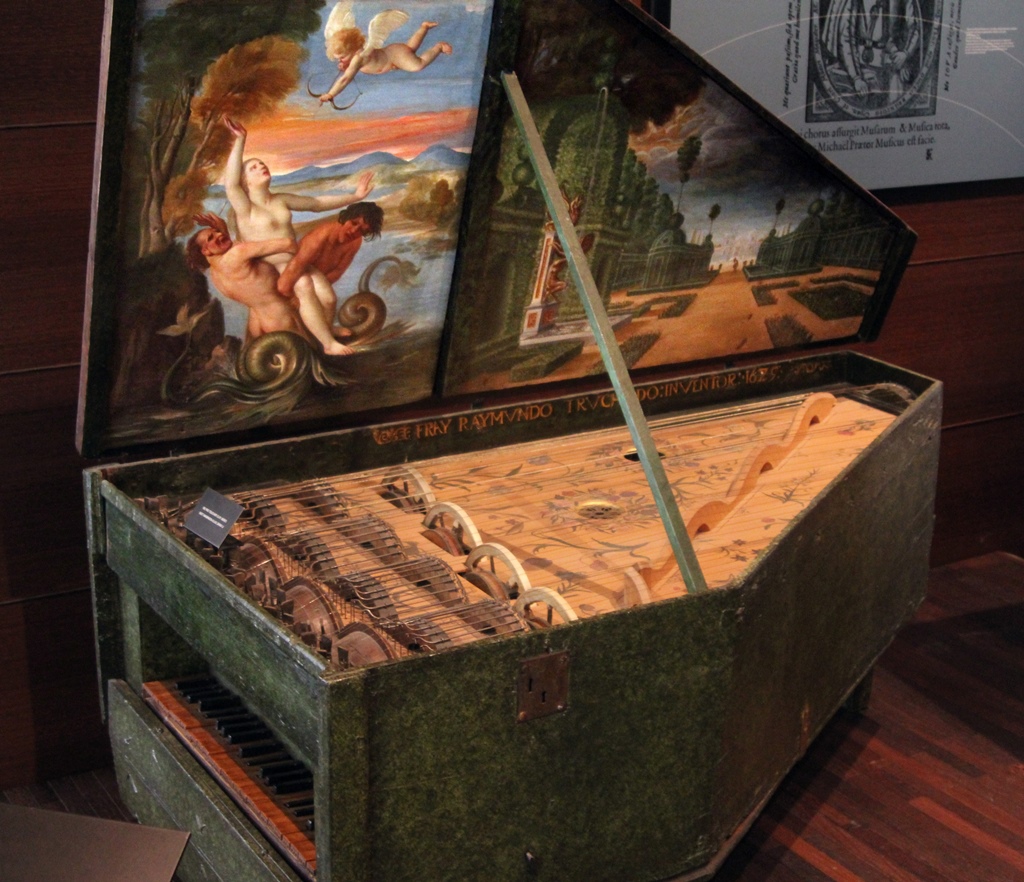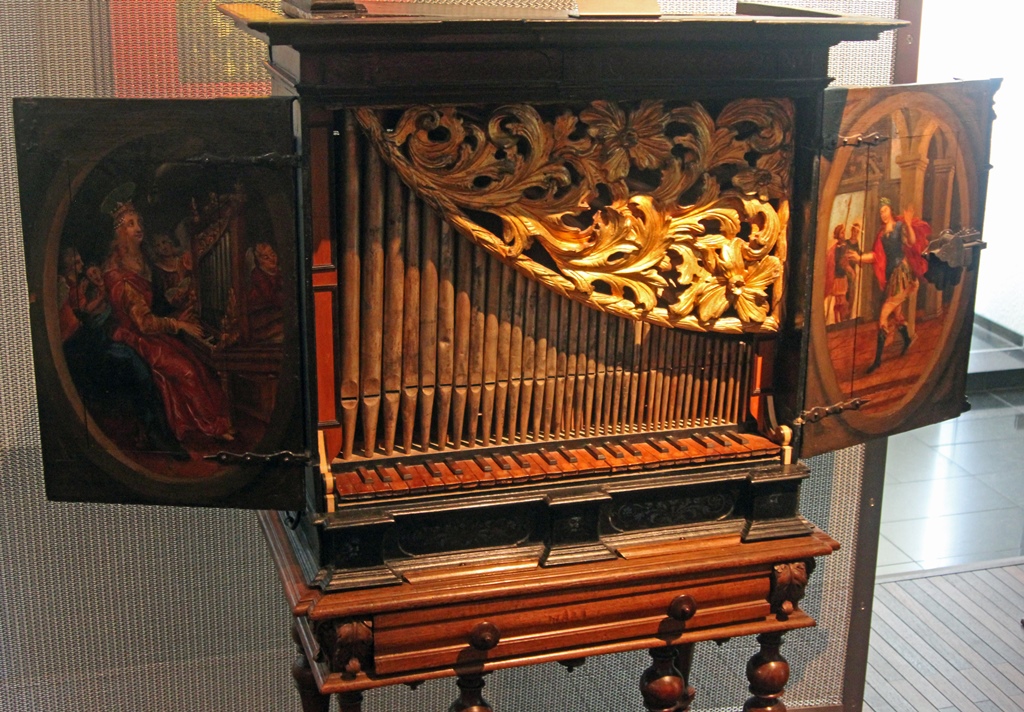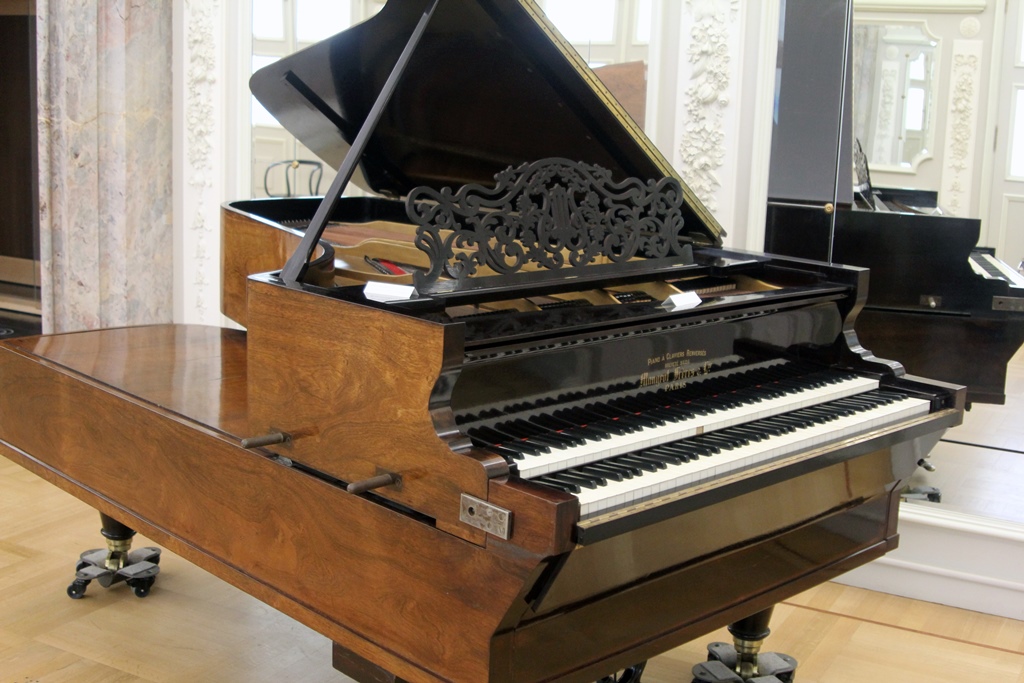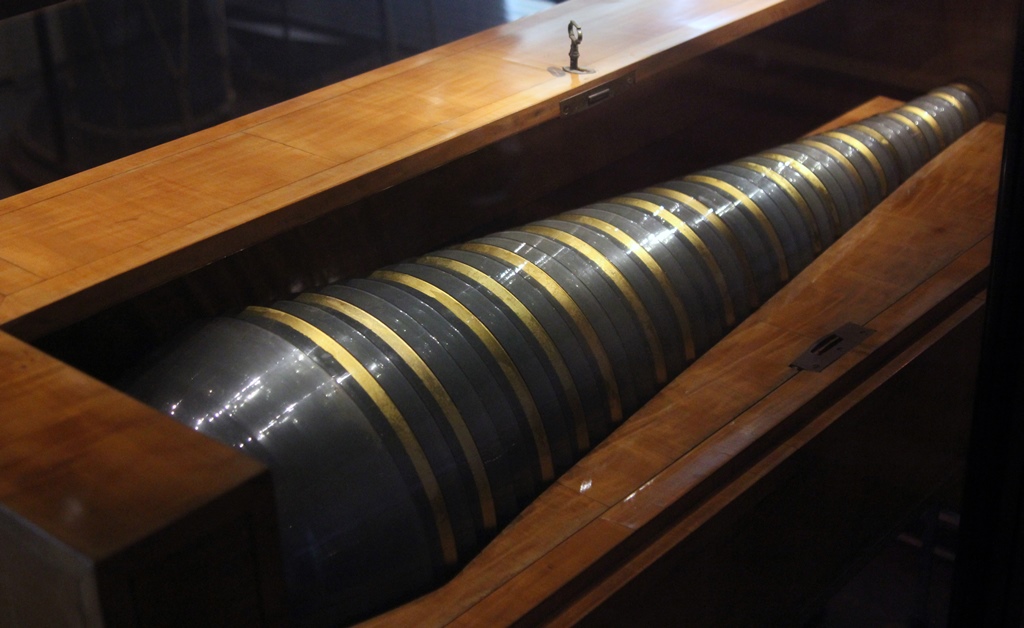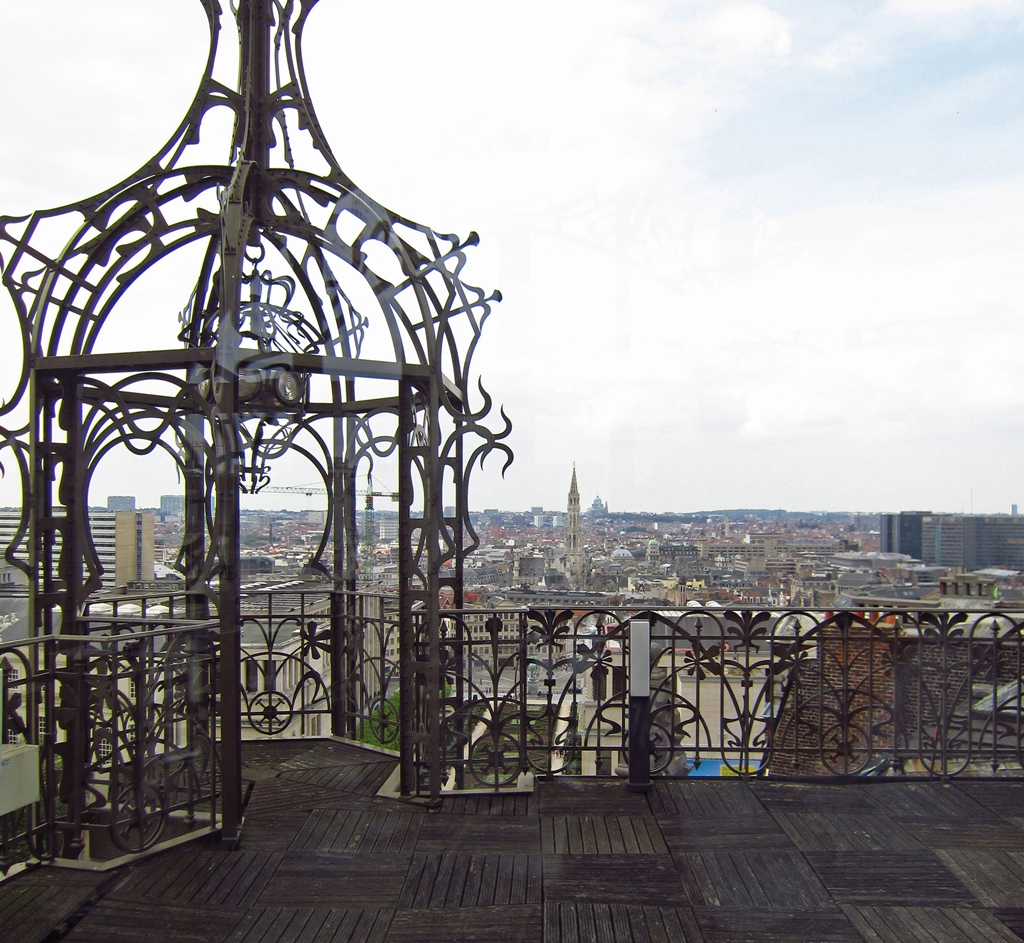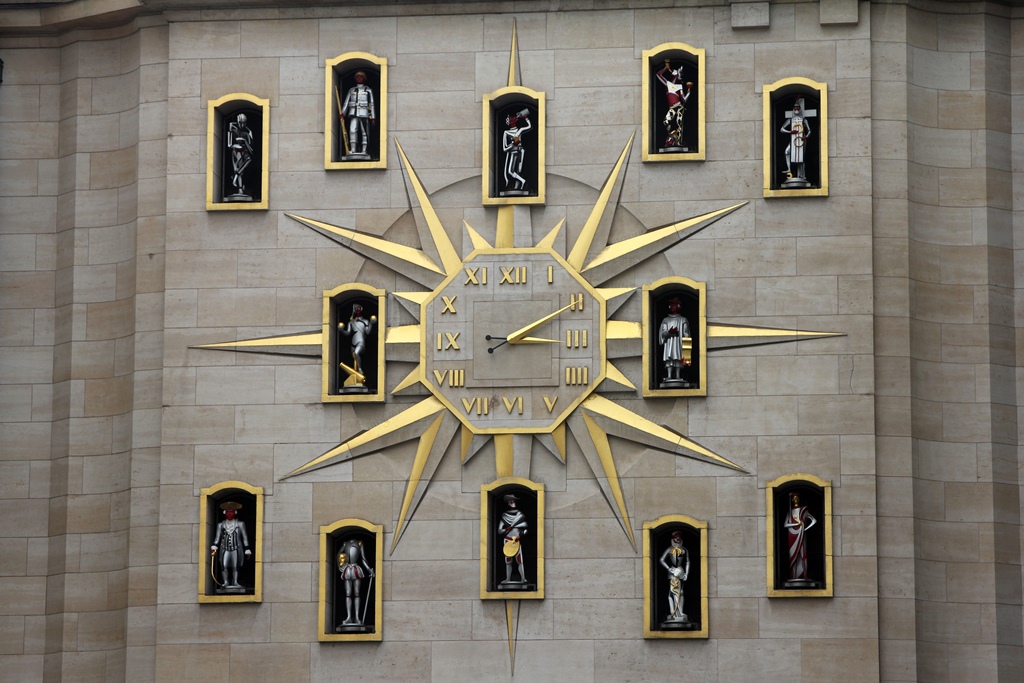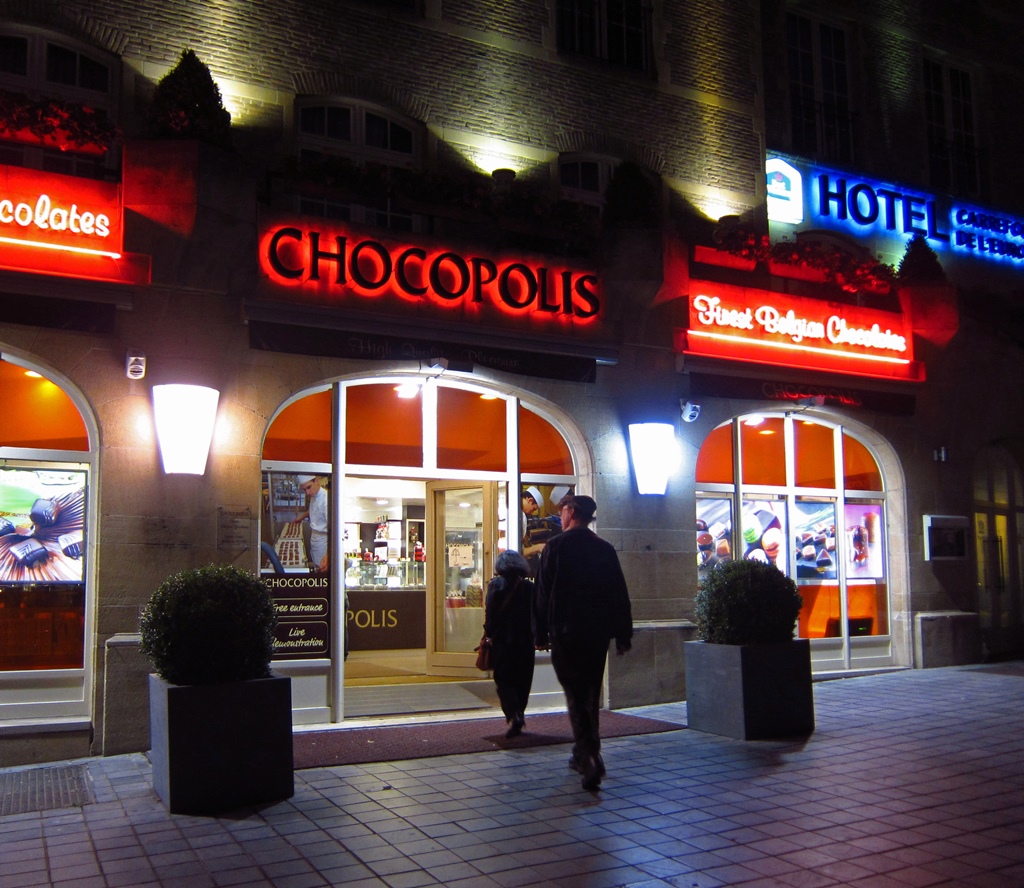The Brussels Musical Instruments Museum was established in 1877 as part of the
Brussels Royal Music Conservatory. Its original collection was already owned by
the Conservatory at that time, but was greatly expanded by its first curator, a
man named Victor-Charles Mahillon. Expanded enough so that it didn’t really fit
into the space that had originally been allocated for it. Buildings were expanded,
and others acquired to make space for storage, display and administration of the
collection, which grew further under succeeding curators. Eventually it was decided
that the museum was too fragmented, and in 1978 two buildings once owned by the Old
England department store were purchased for the museum. One of these buildings was
a neoclassical building on the Place Royale. But the building to be used for
display of the collection had been built in 1899 in the art-nouveau style according
to a design by architect Paul Saintenoy. The building had been vacated in 1972 and
had fallen into a certain amount of disrepair. But it was large enough for the
envisioned display space, and a careful restoration would make for a very attractive
building. This is eventually what happened, but it took awhile. The Musical
Instruments Museum (or "mim") in its present form was opened in the year 2000.
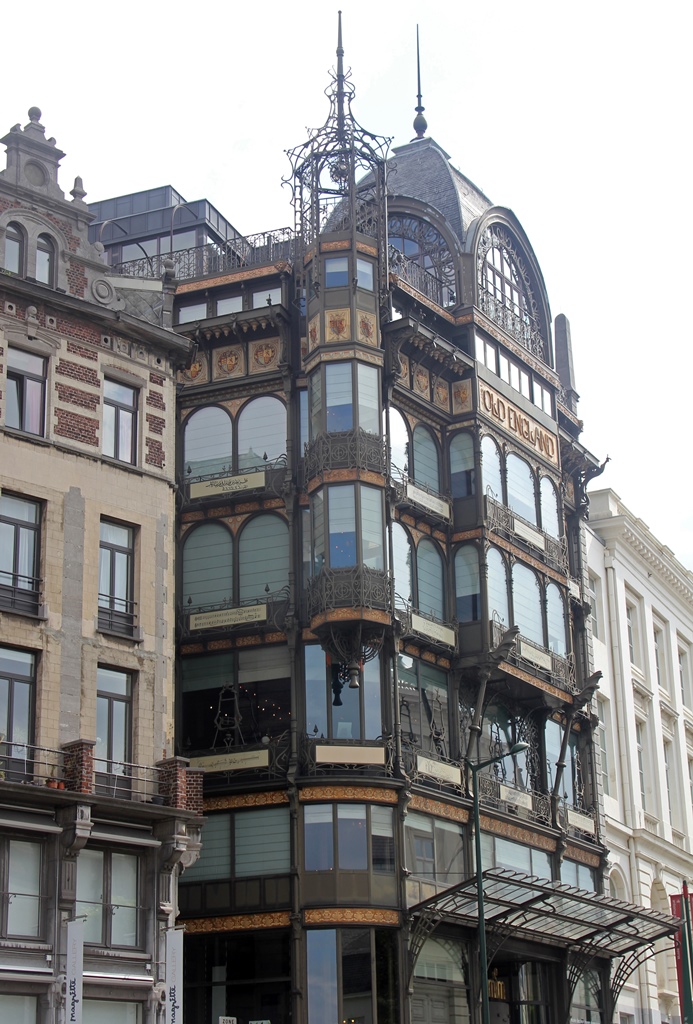
Building Exterior
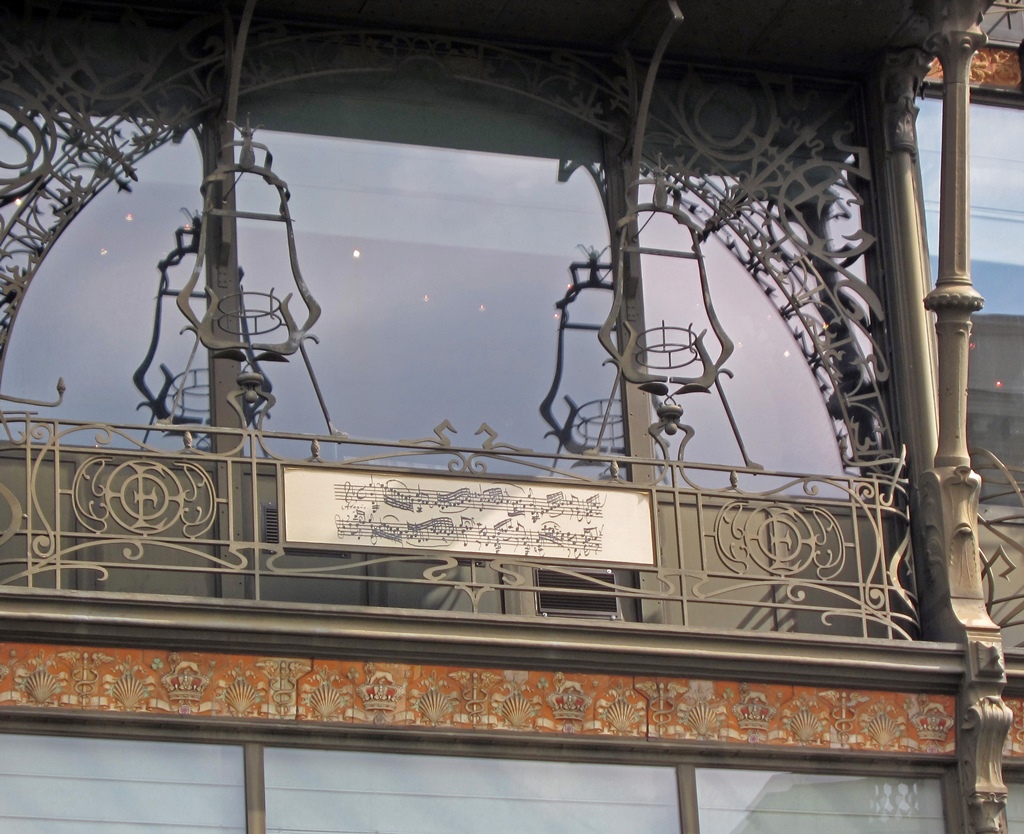
Musical Notes
The displays in the museum mostly have placards describing them. There is
good news, in that the placards are bilingual. But the bad news is that
the languages are French and Dutch. Fortunately visitors are given audioguides
in chosen languages on entering, which describe some of the exhibits and in
some cases actually play examples of what the instruments sound like (some of
this is also available on the museum’s website).
And a good thing, as the sound and the description are often less than
obvious. We weren't allowed to keep the audioguides, though, so some of the
descriptions and captions below may be imprecise.
As we walked through the displays, we saw exactly what one would expect from a Musical
Instruments Museum – a large number of conventional musical instruments.
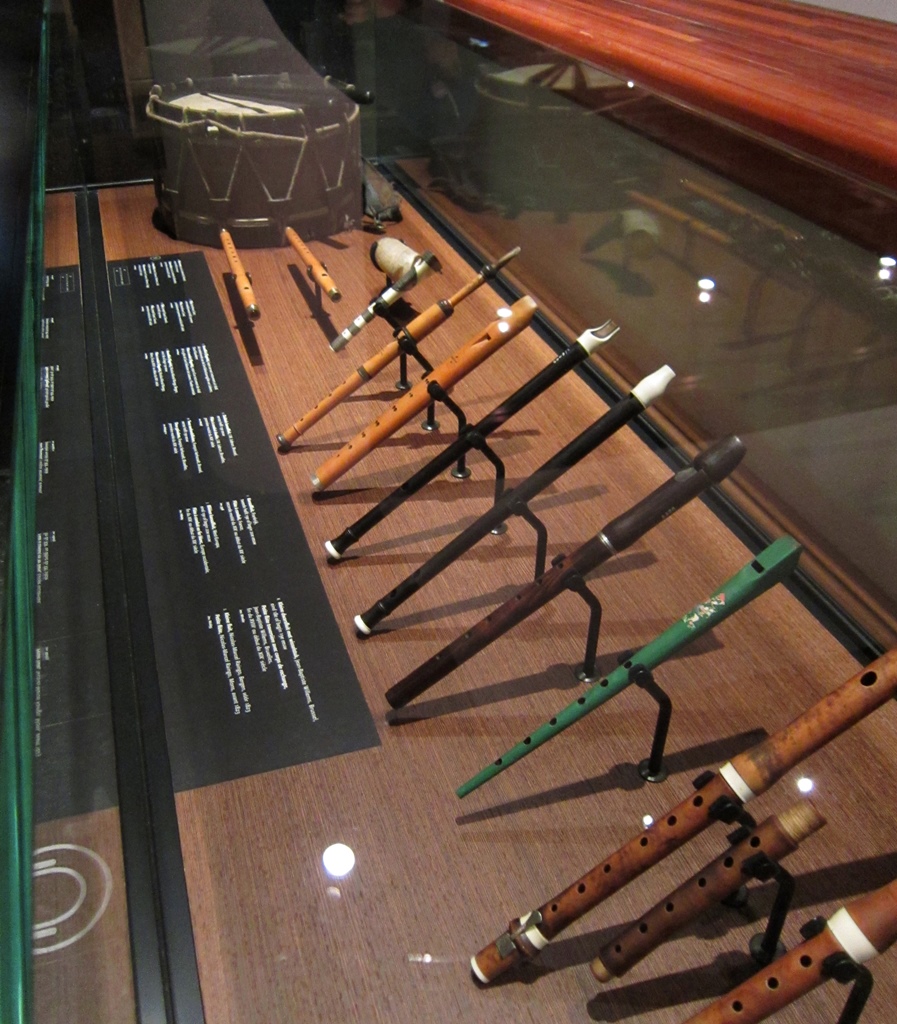
Wooden Flutes
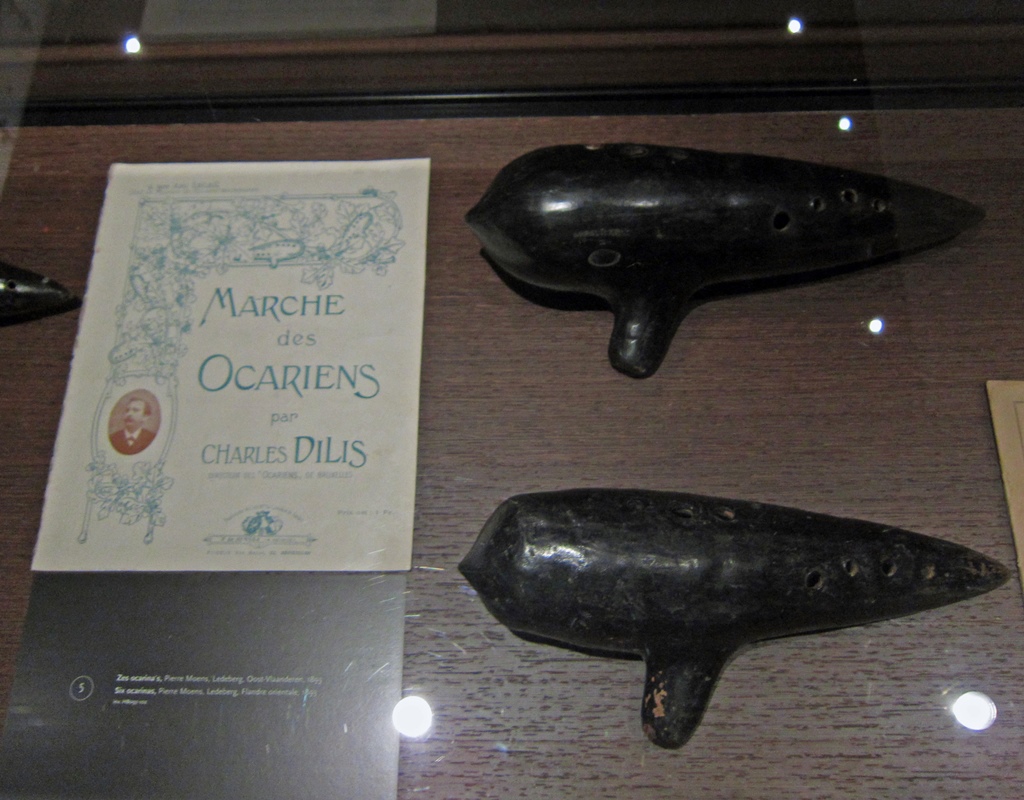
Ocarinas
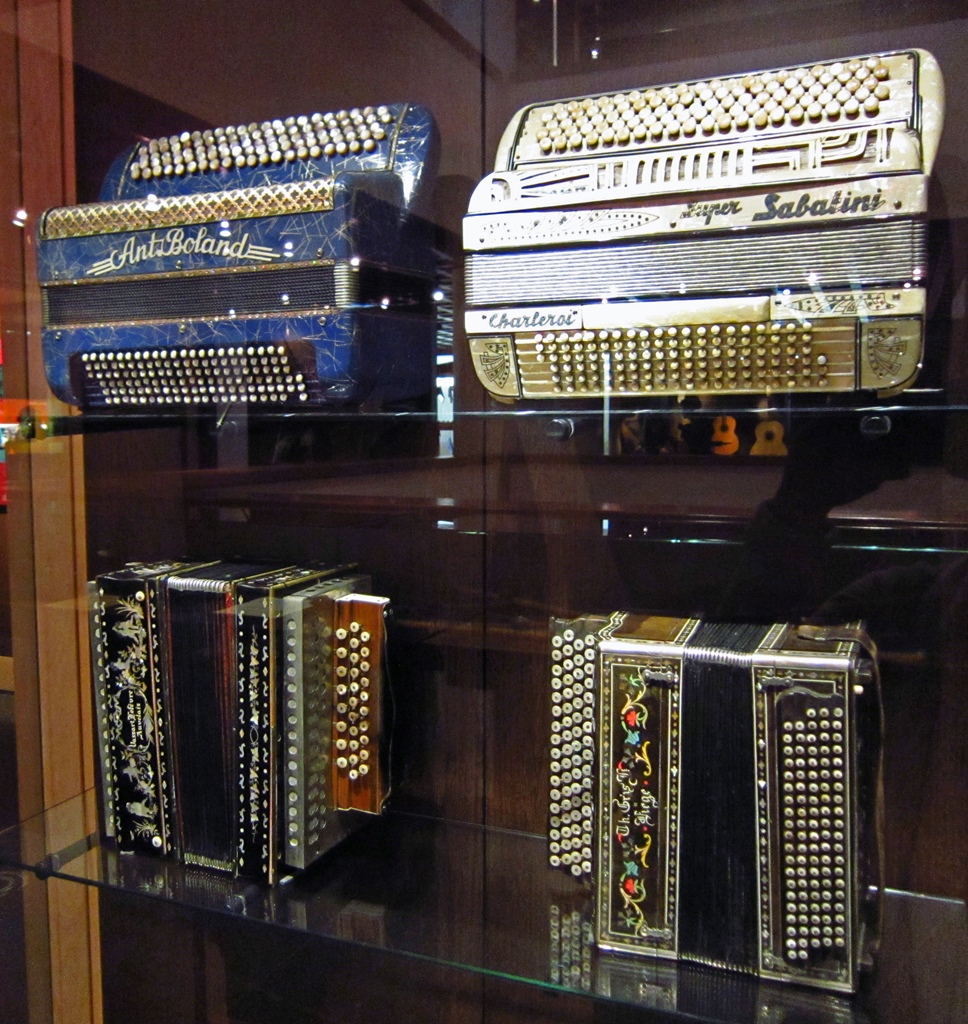
Accordions
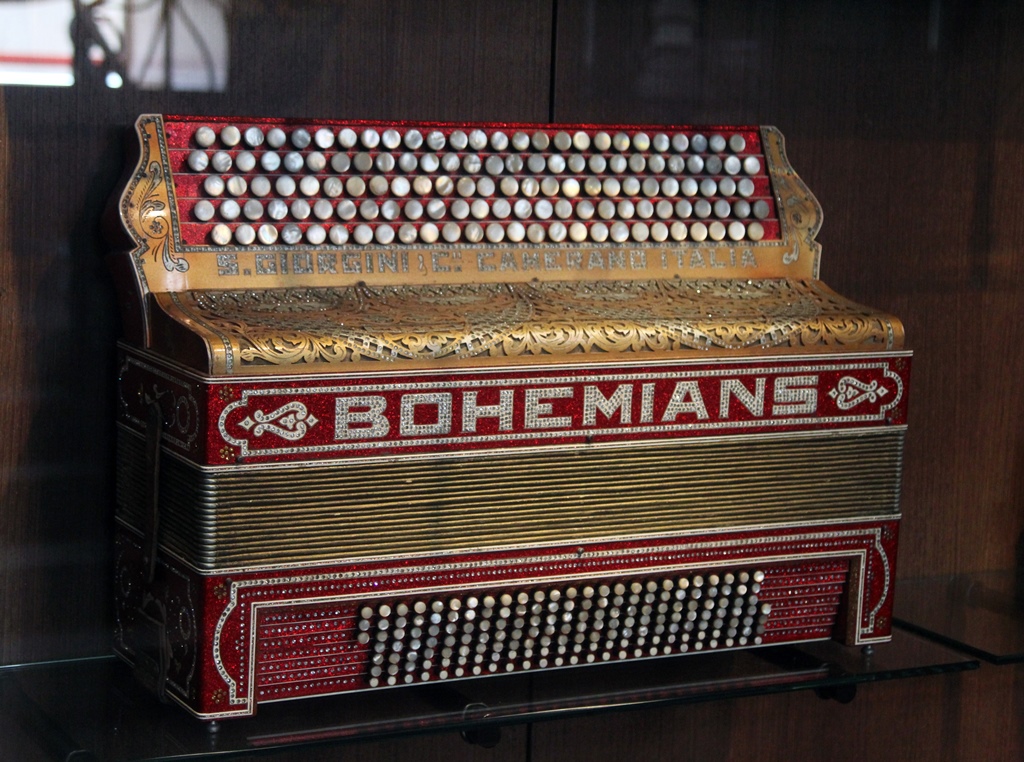
Italian Accordion
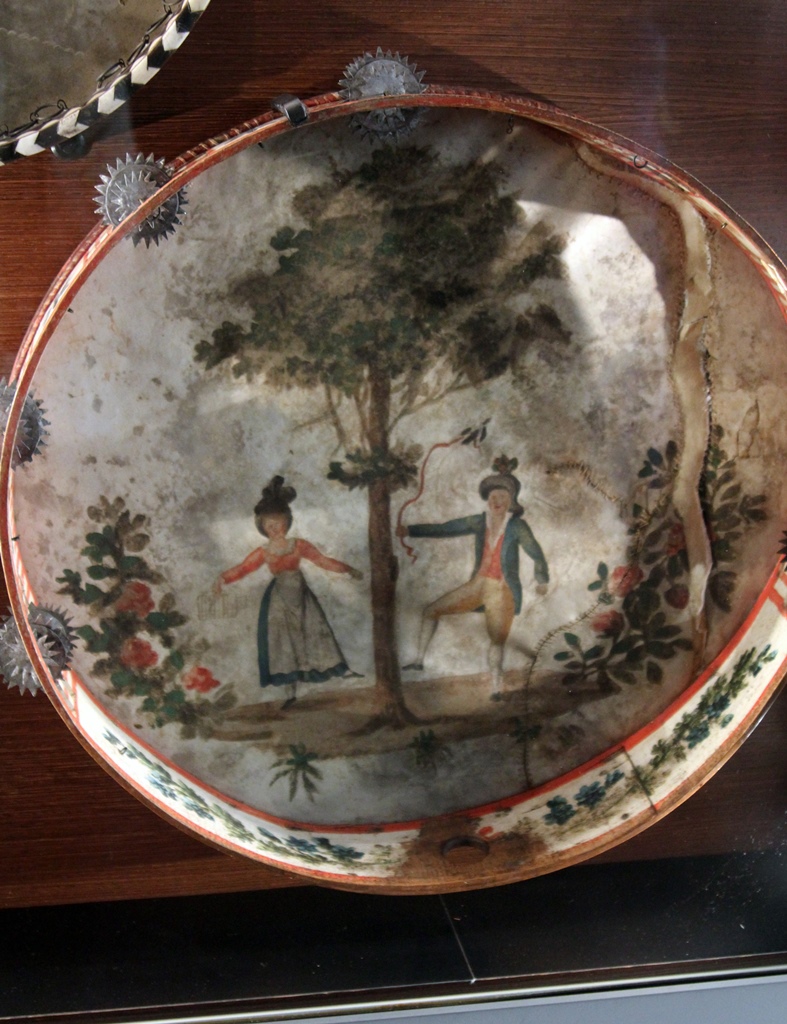
Tambourine
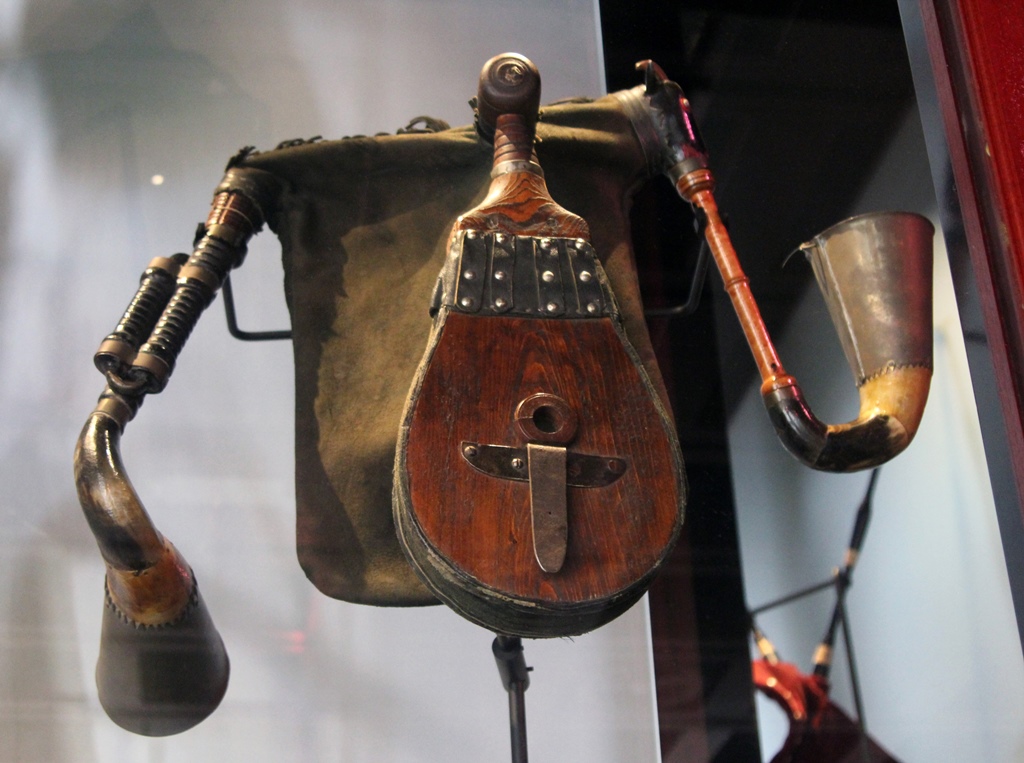
Bagpipe
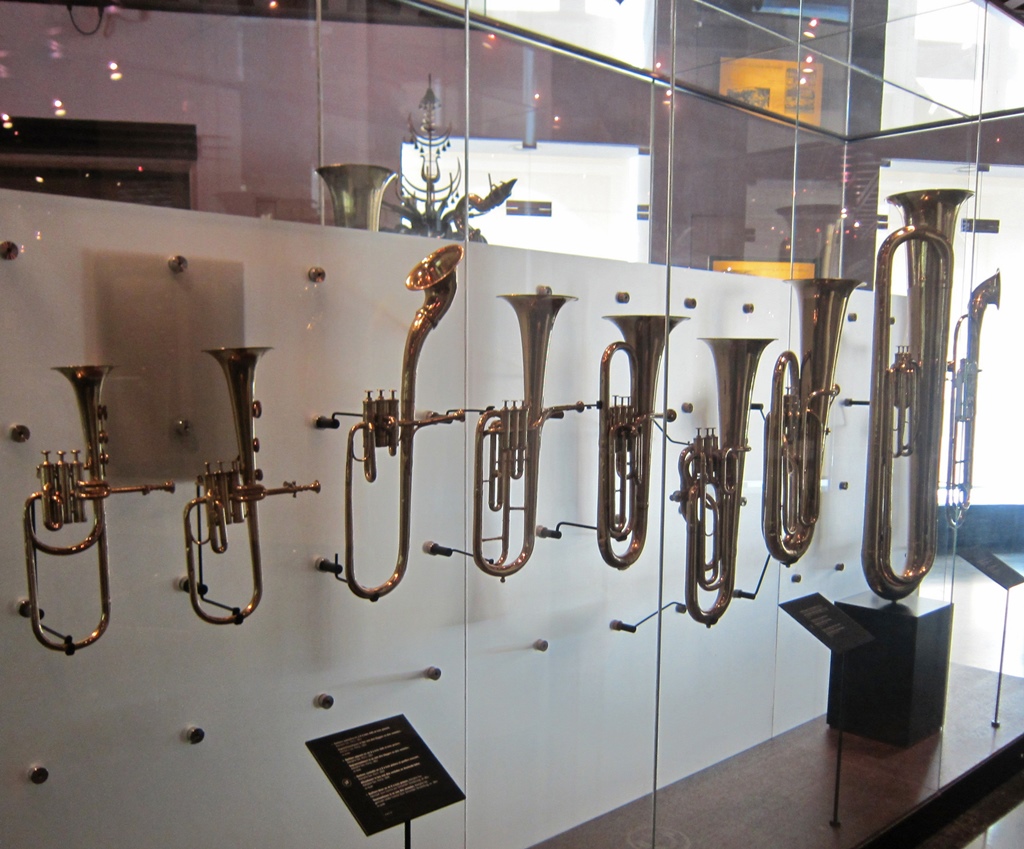
Valved Horns
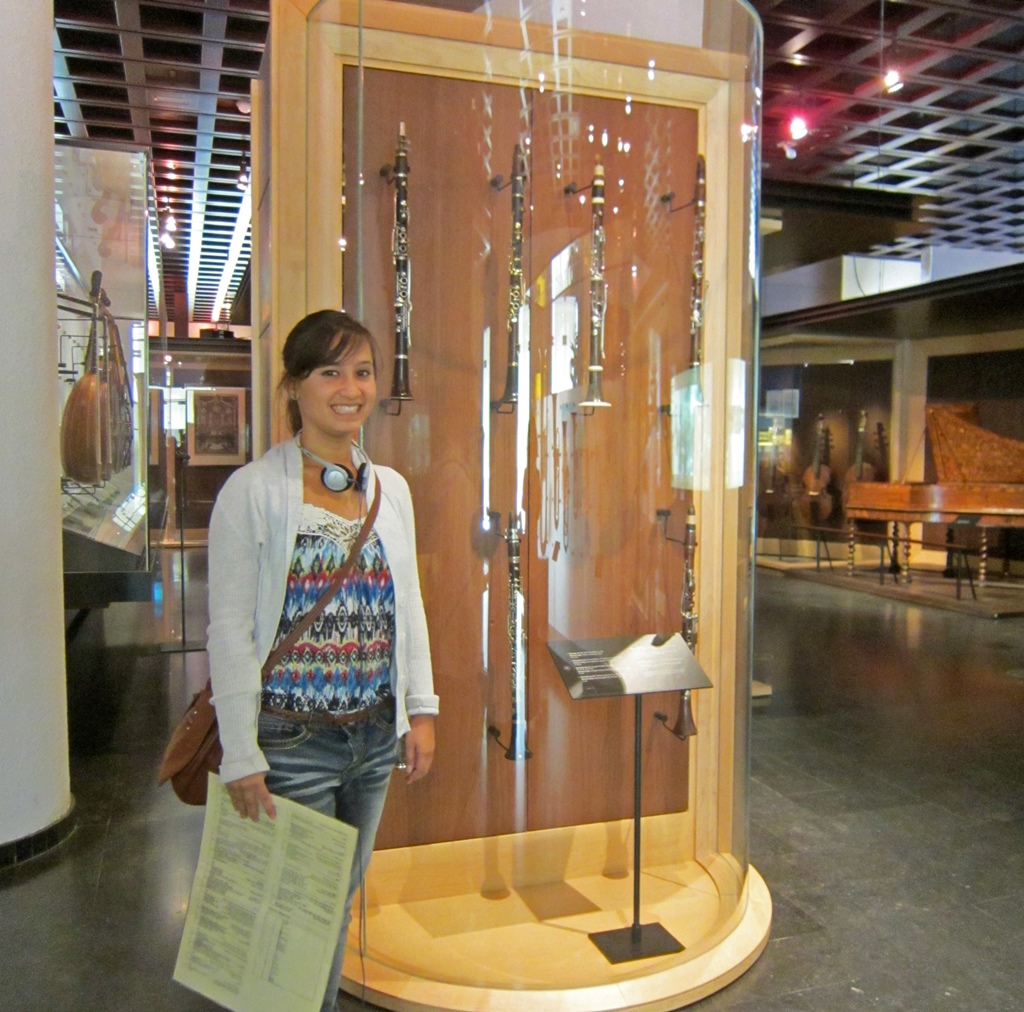
Connie and Clarinets
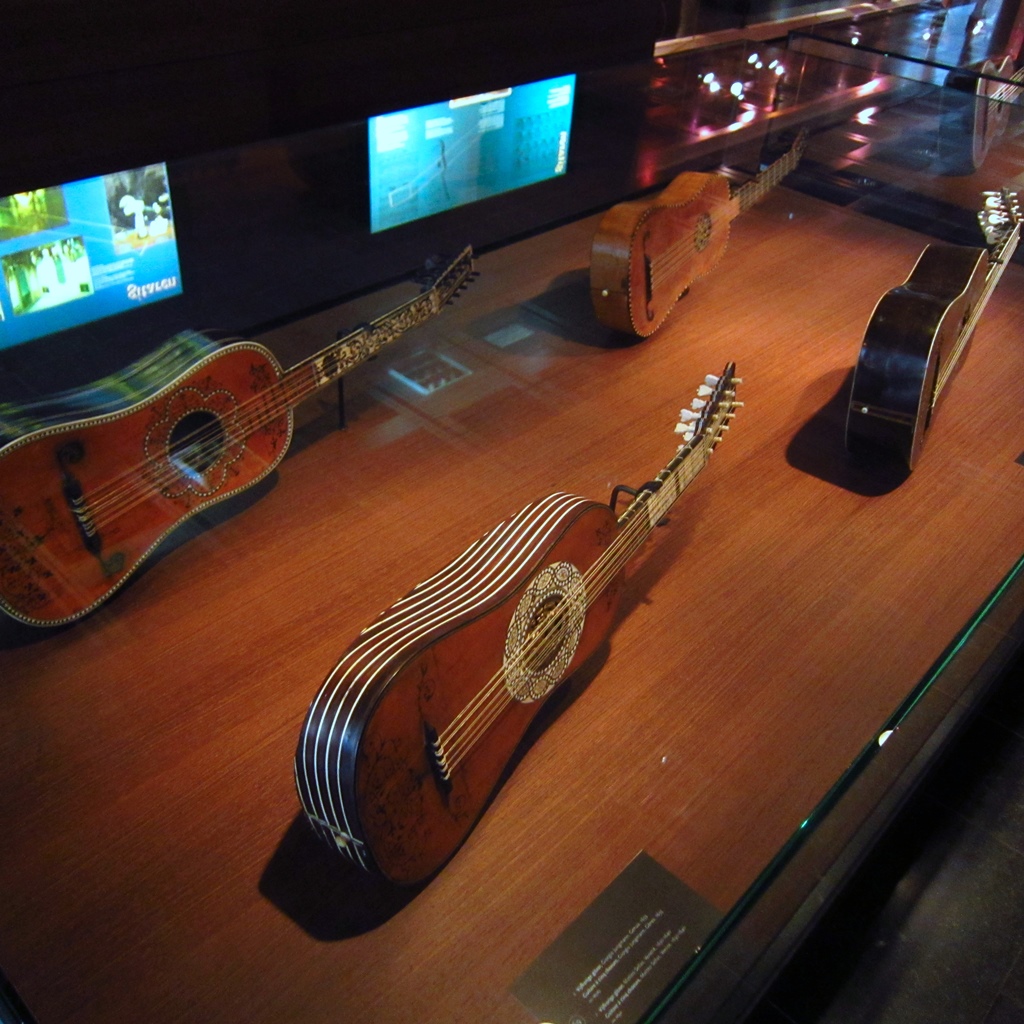
Guitars
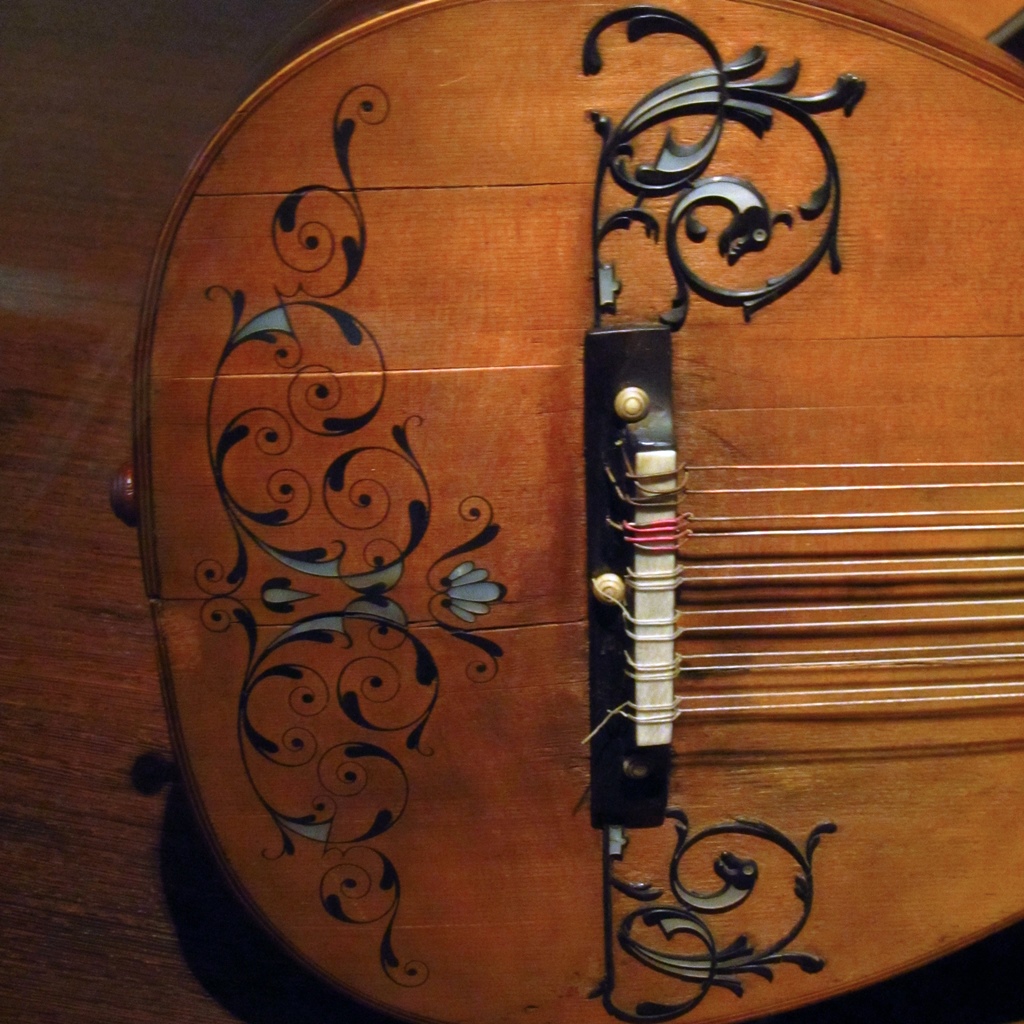
Guitar
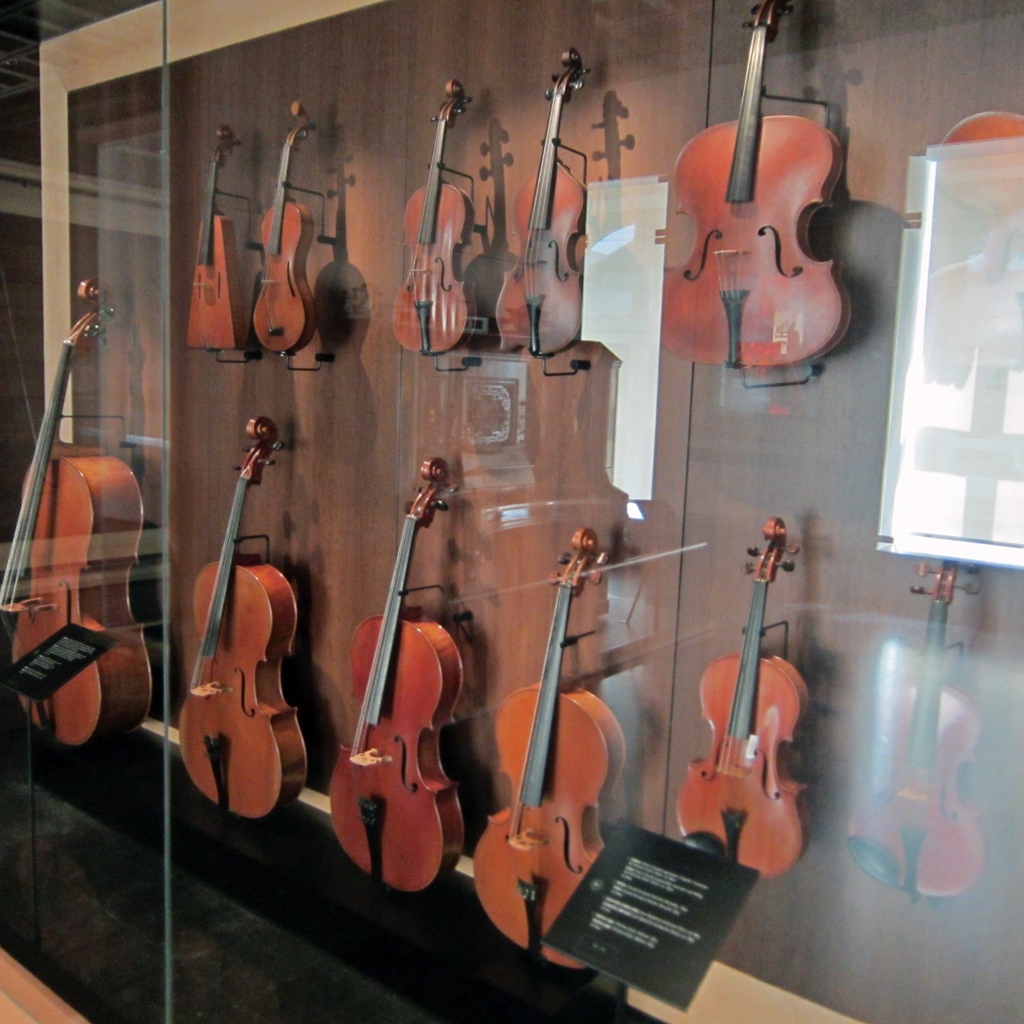
Violins, Violas, Cellos
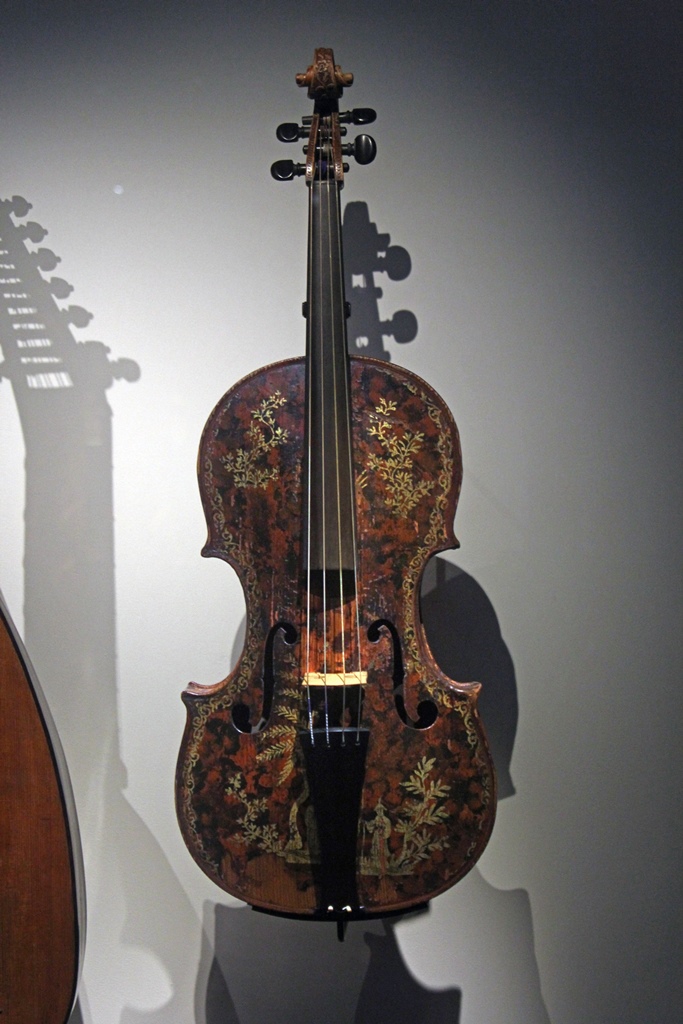
Elaborate Violin
Instrument Repair Shop
But on closer inspection (and helpful descriptions from the audioguide), some of the
instruments were not exactly what they seemed to be. For example, the instrument
below, known as a "Hardanger fiddle", is a Norwegian instrument that appears to be
an elaborately decorated violin. This is partly true, but beneath the usual set of
strings there is a second set of strings that resonates with the melody strings to
produce a more complex sound (you can hear a short sample on
the website).
Hardanger Fiddle (Norway, 1812)
Some of the displayed instruments were reflective of the technology available at the
times in which they were created.
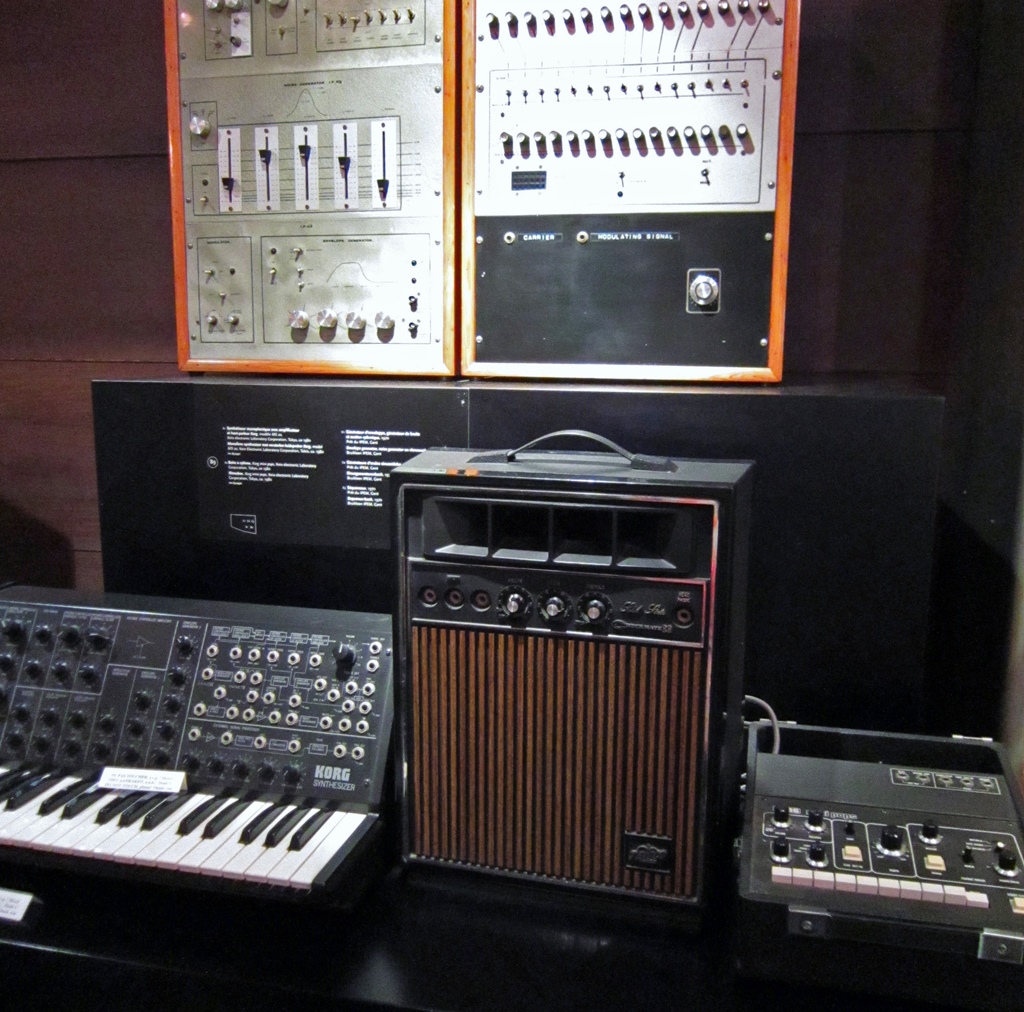
Synthesizer Equipment
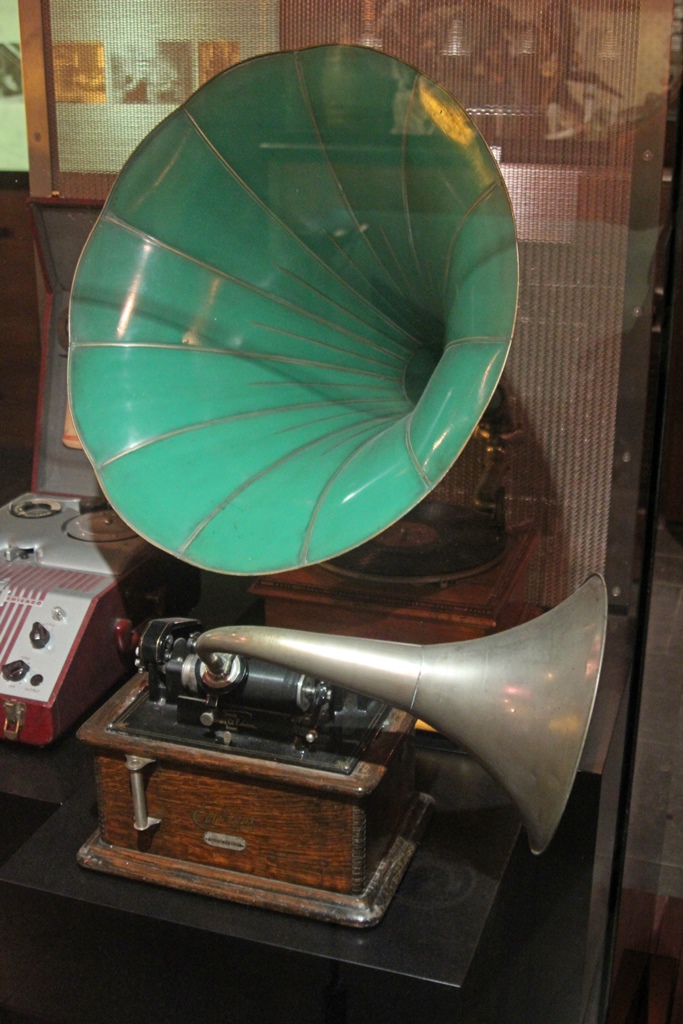
Gramophones (ca. 1900)
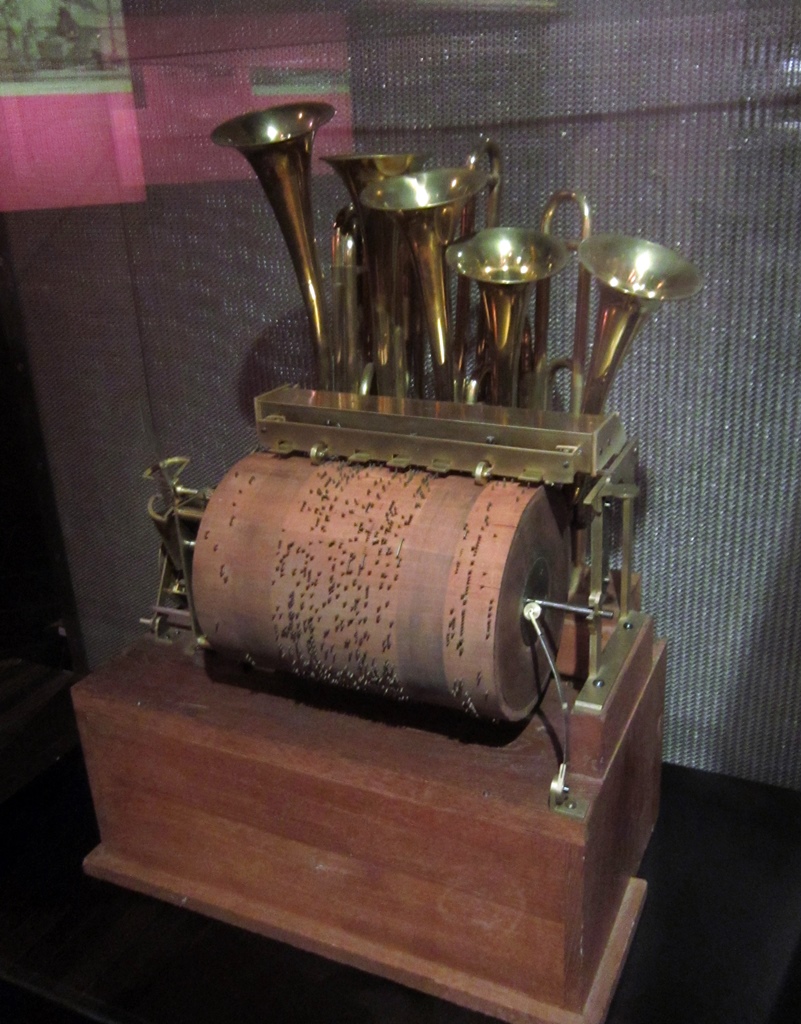
Jeu de Trompettes, Paris (1828)
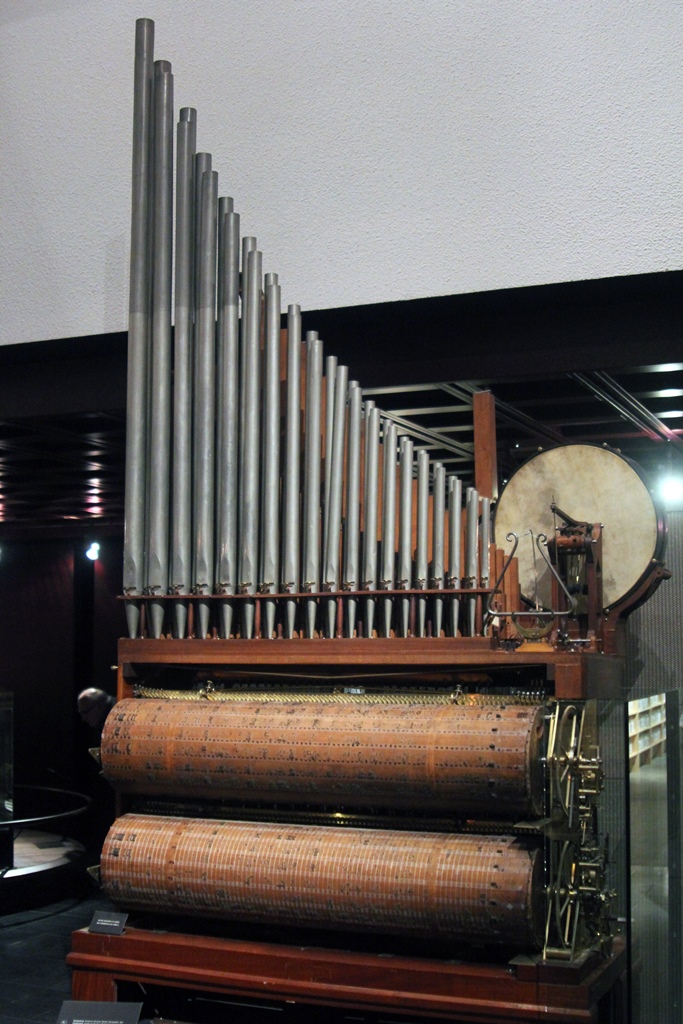
Componium, Amsterdam (1821)
Hurdy-Gurdy (Vielle à Roue, 18th C.)
Some such instruments were used for street entertainment. For example, the following
is a mechanically animated tableau called "The Dentist", that tells a comical and
highly politically incorrect story while music plays from the
barrel organ
on which it is mounted.
"The Dentist", Animated Barrel Organ Display (19th C.)
Other instruments looked unfamiliar, often because they were from another part of
the world or from an earlier time.
Épinettes (17th-20th C.)
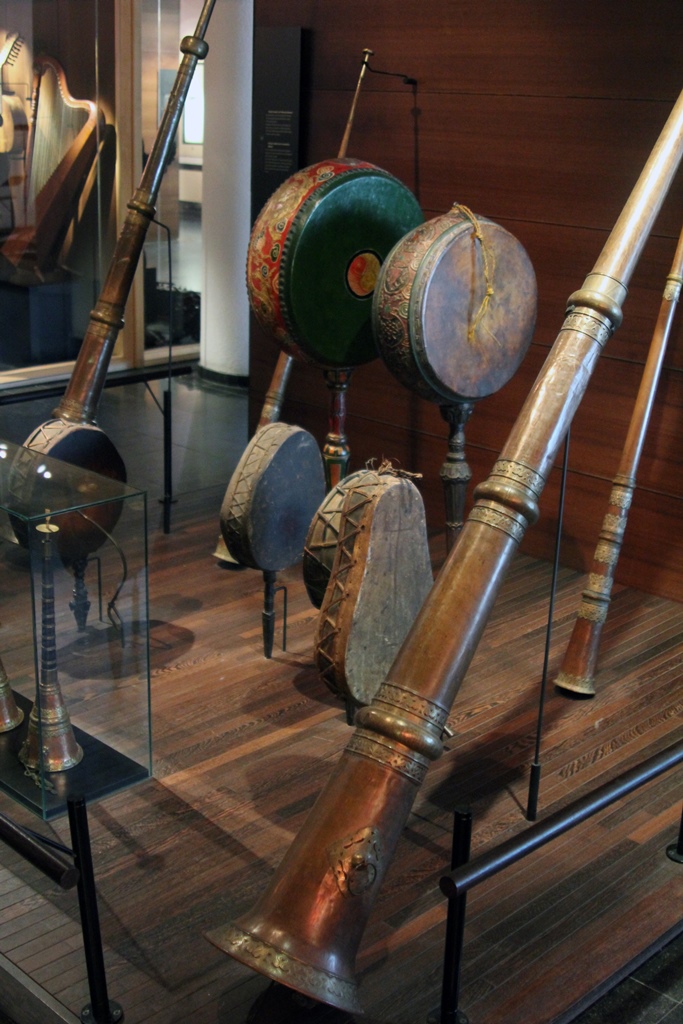
Tibetan Instruments
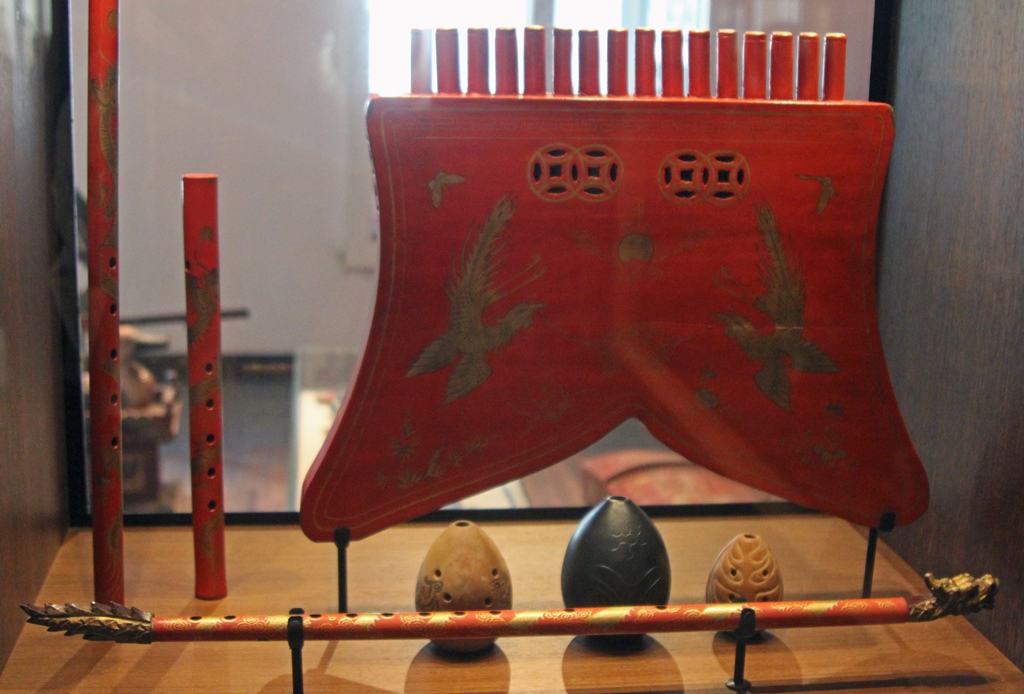
Chinese Instruments
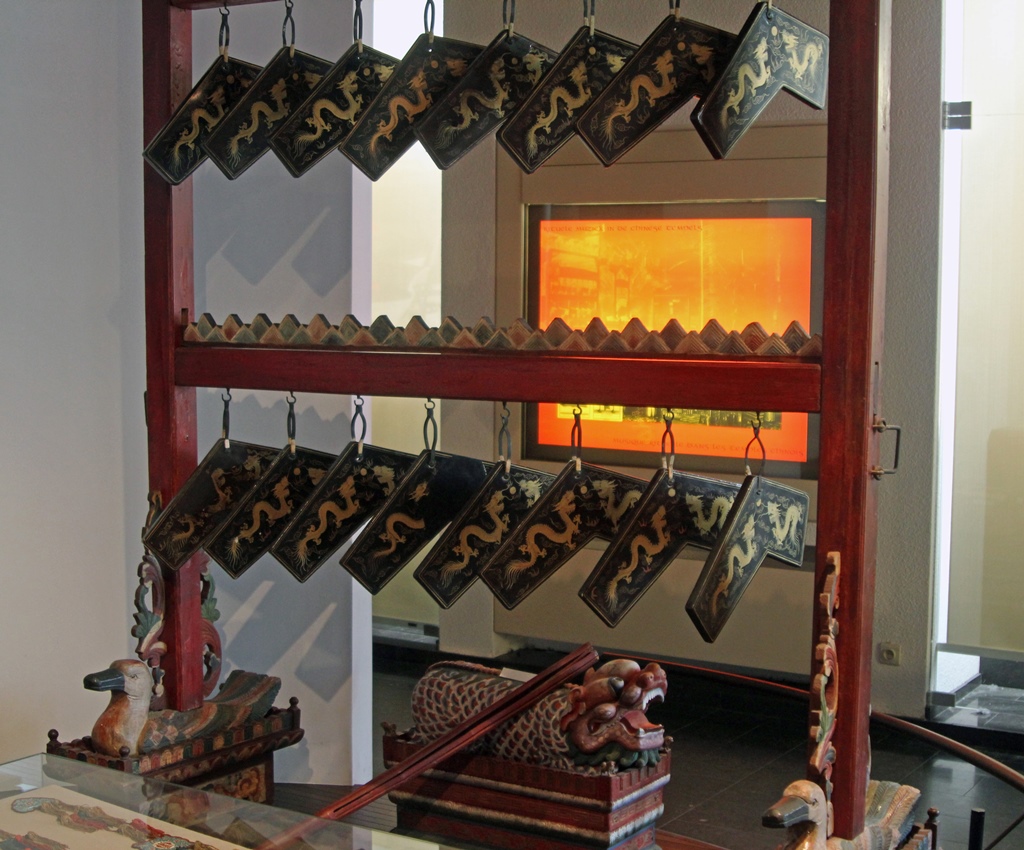
Chinese Bianqing
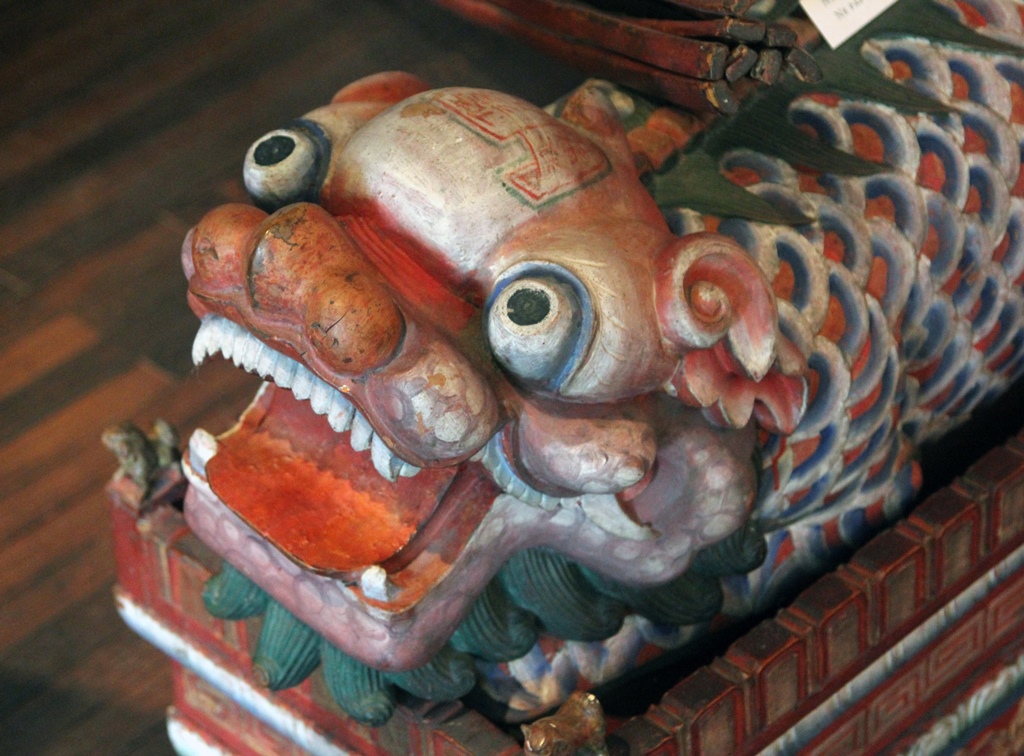
Yu in the Form of a Tiger (China)
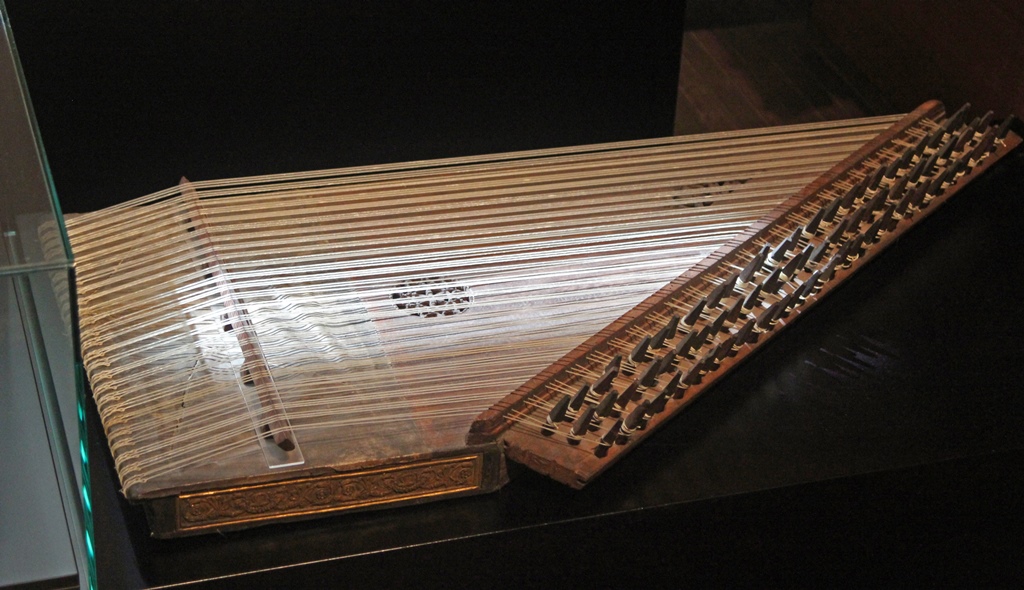
Zither
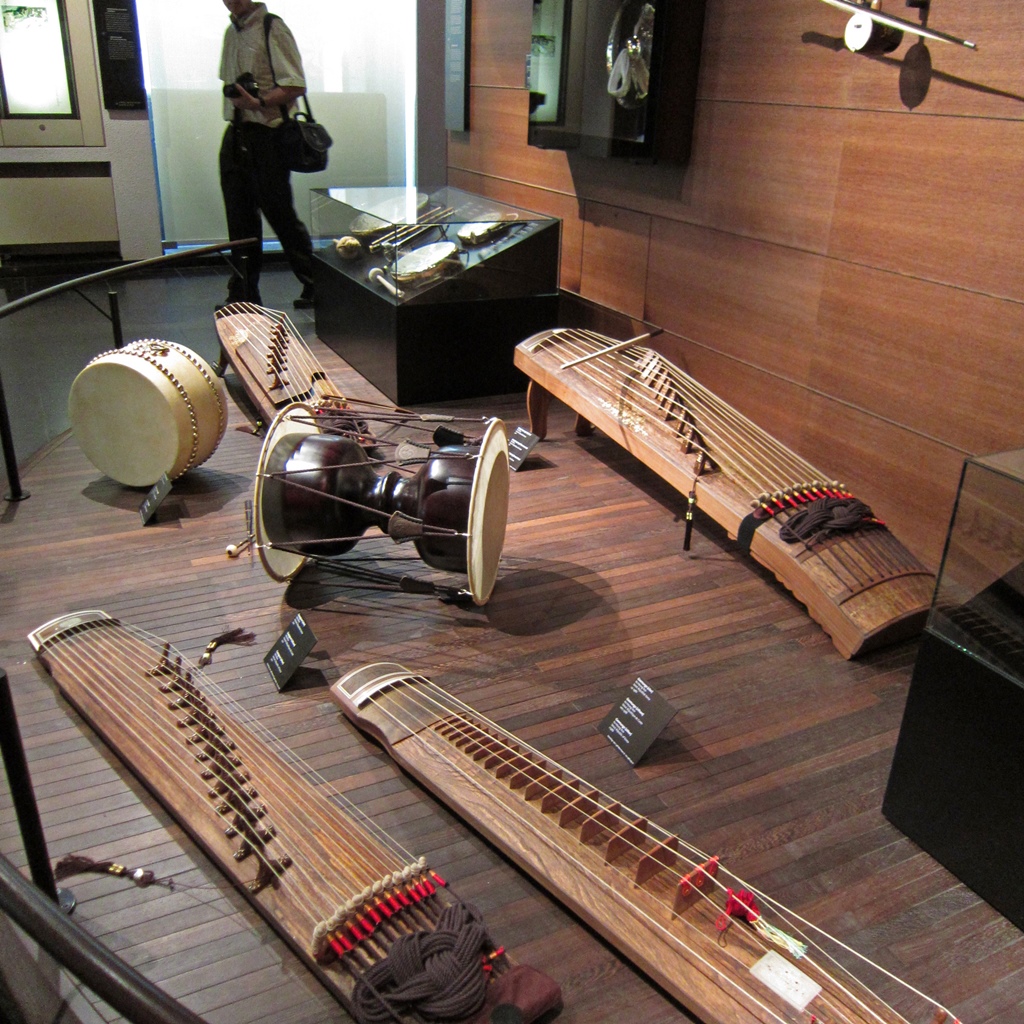
Korean Zithers
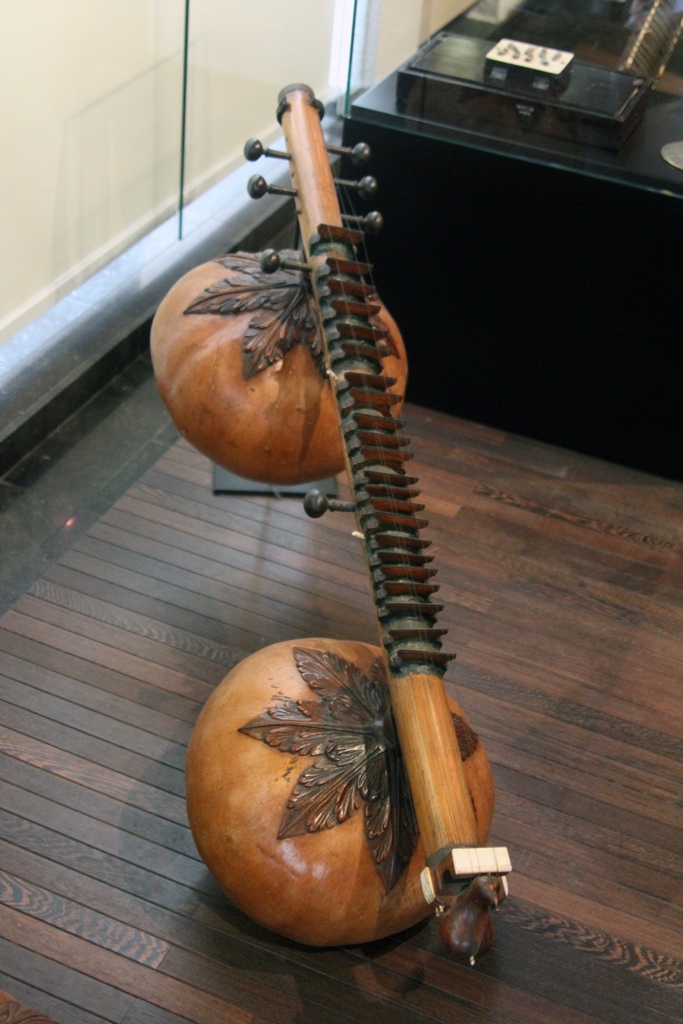
Stringed Instrument with Gourds
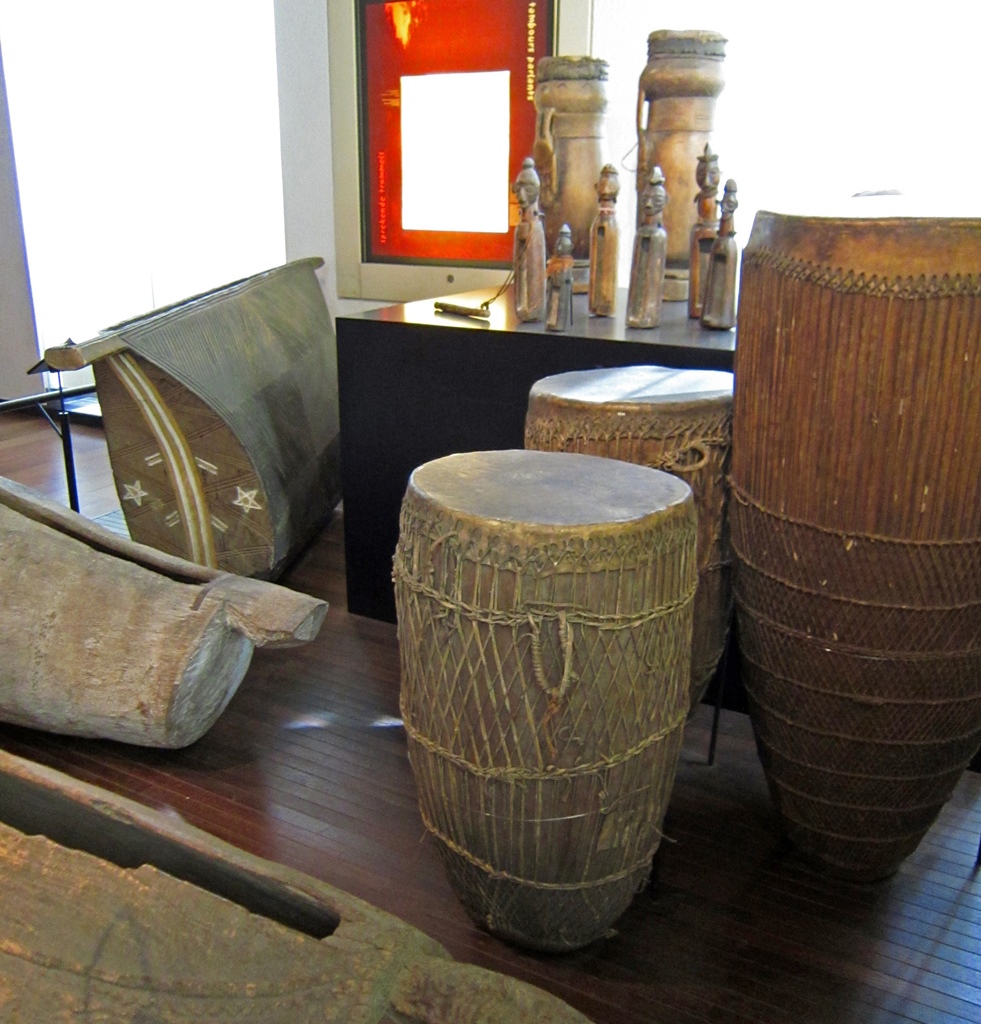
Drums
Some instruments ranged from imaginative to just bizarre.
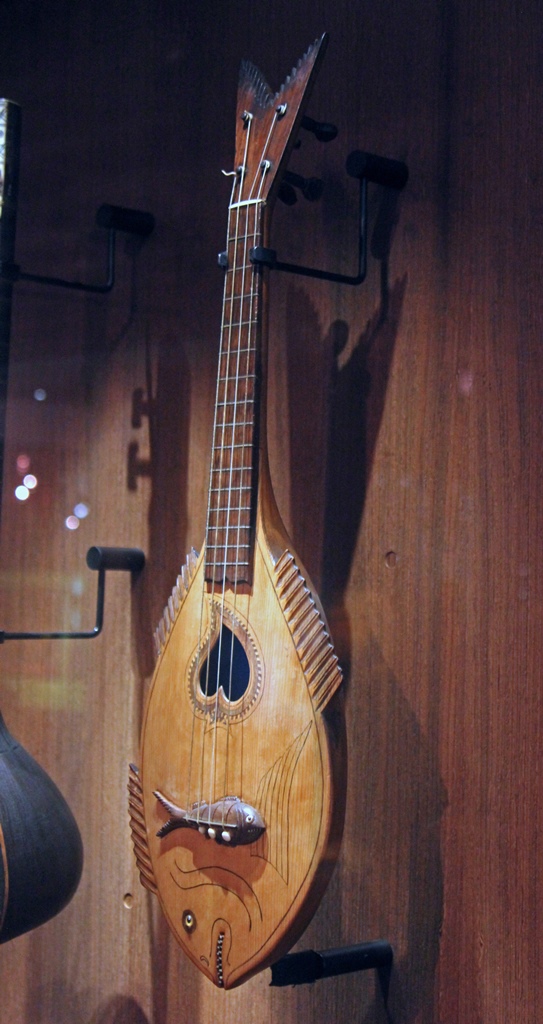
Fishy Guitar
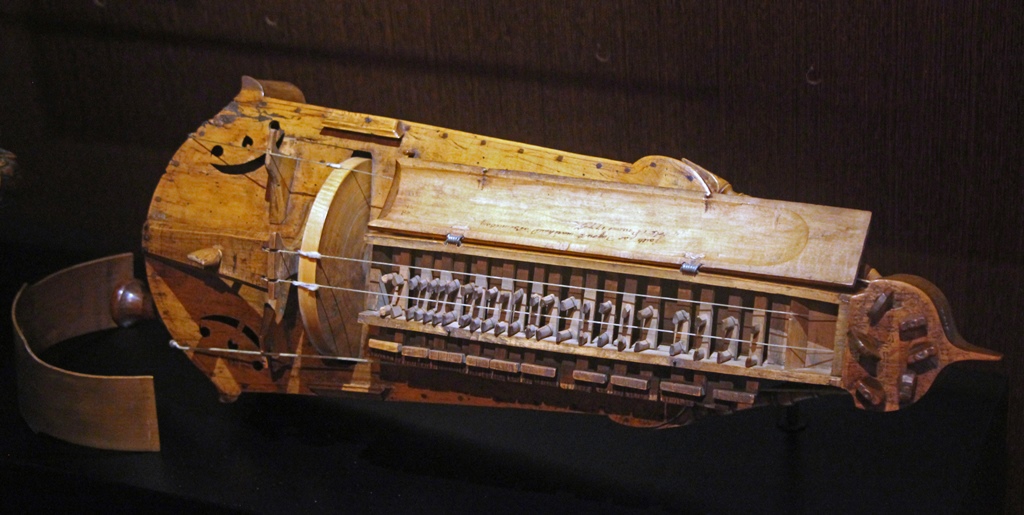
???
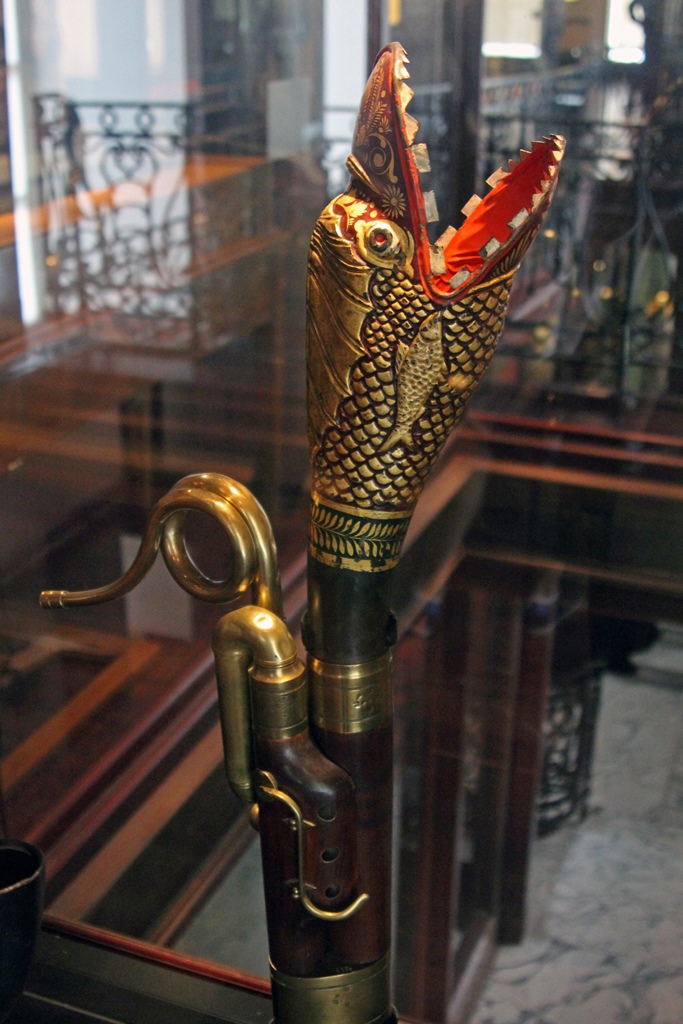
Dragon-Fish Instrument
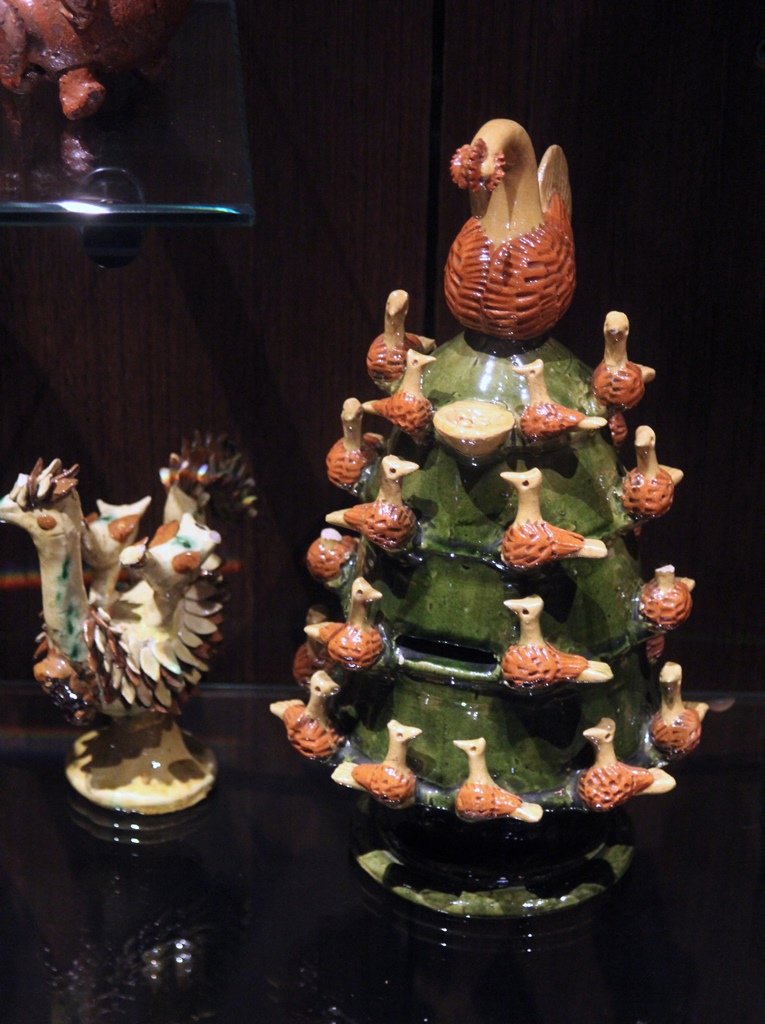
Ceramic Wind Instruments
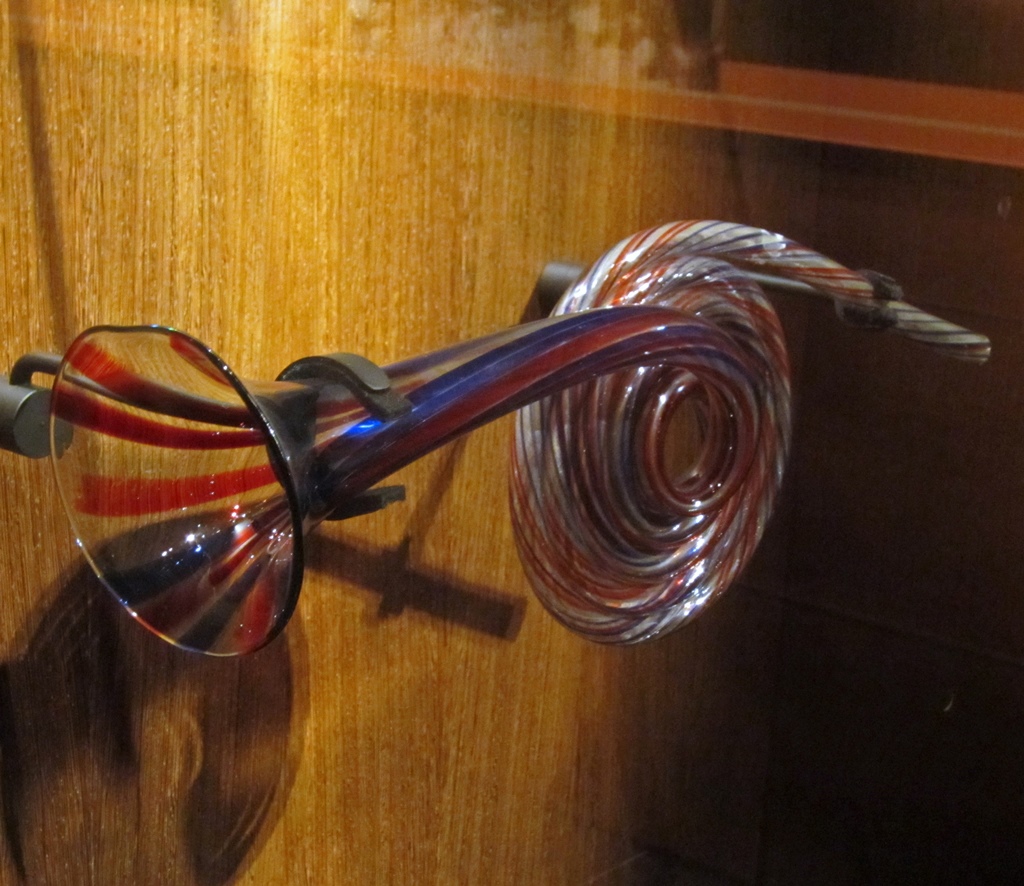
Glass Horn
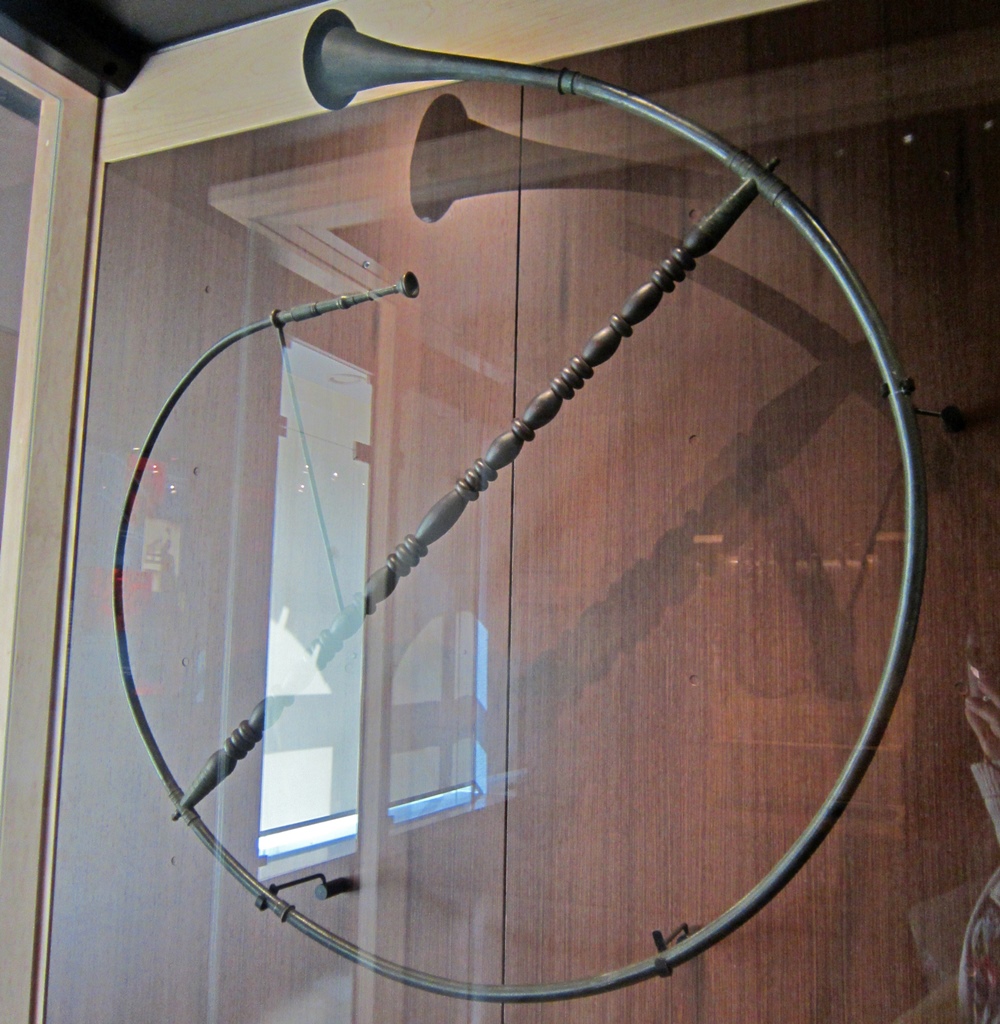
Wrap-Around Horn
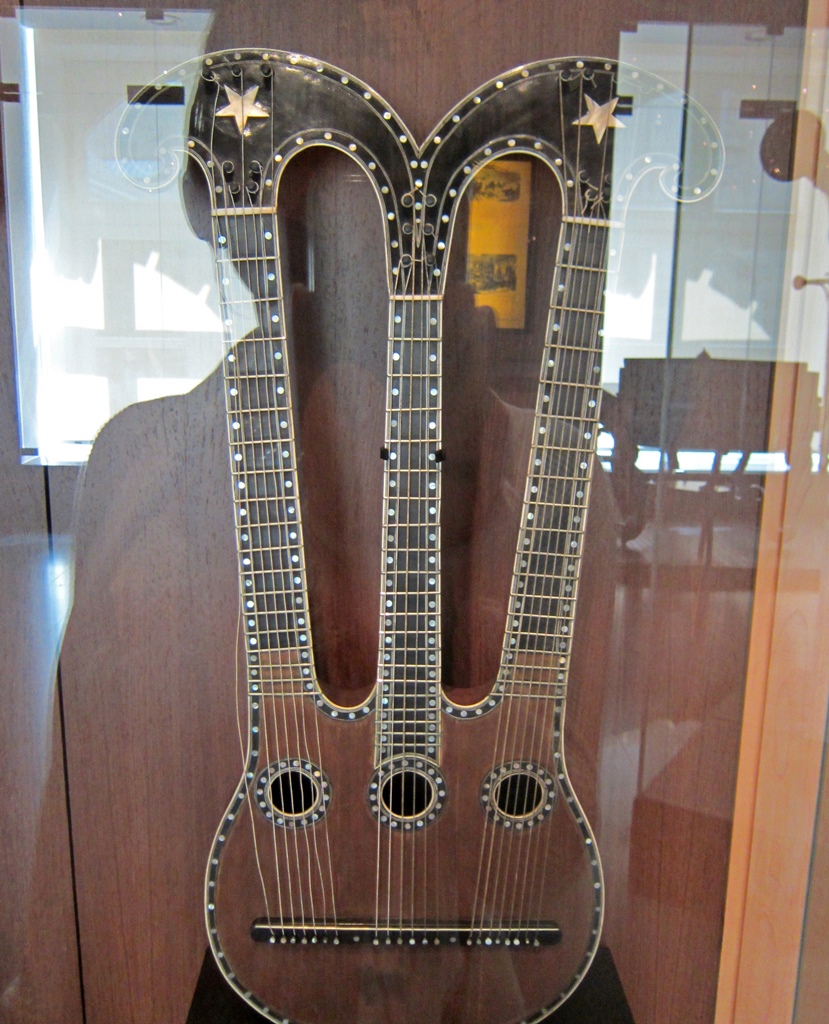
Triple-Necked Guitar
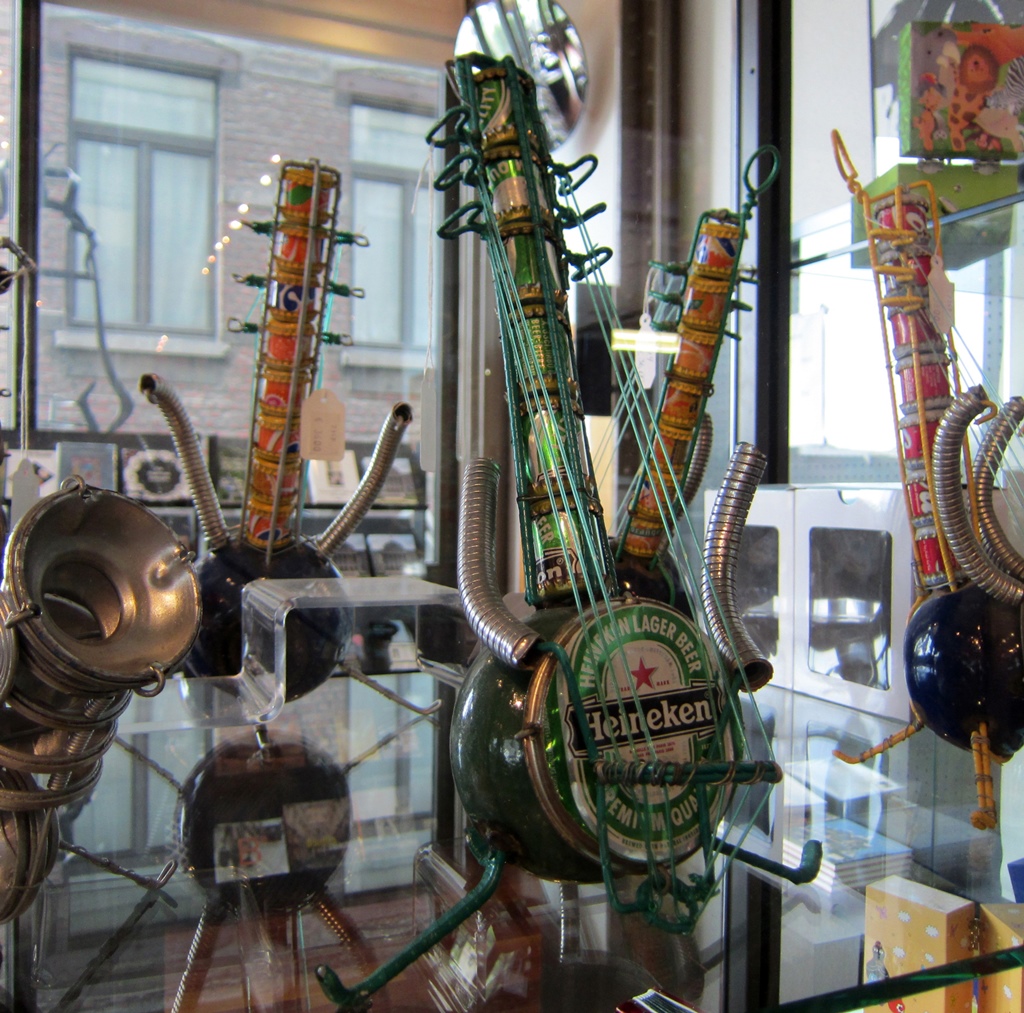
Beer Can Instruments
One display had us puzzled for awhile, as there didn’t seem to be any possible
way to play it. There were some other instruments nearby called "serpents", which
were roughly tubular wind instruments that were bent in places so as to appear
snakelike. As it turned out, this display wasn’t an instrument at all, but rather
a chandelier made up of repurposed serpents.
Chandelier Made from Serpents (Early 19th C.)
The museum also displayed many keyboard instruments, some of which were also
works of visual art. There were several beautiful harpsichords, for
example. A harpsichord
makes sounds by plucking strings
inside of it when the keys are pressed, rather than striking them, as in
a piano. A virginal is a smaller, simpler variety of harpsichord.
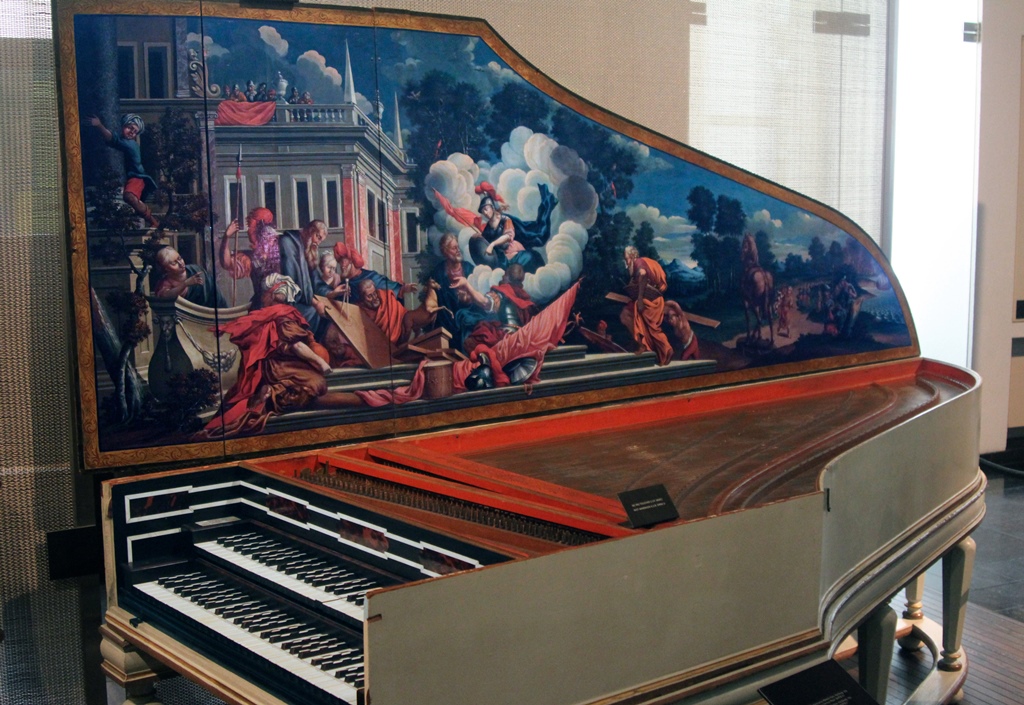
Harpsichord (Hamburg, 1734)
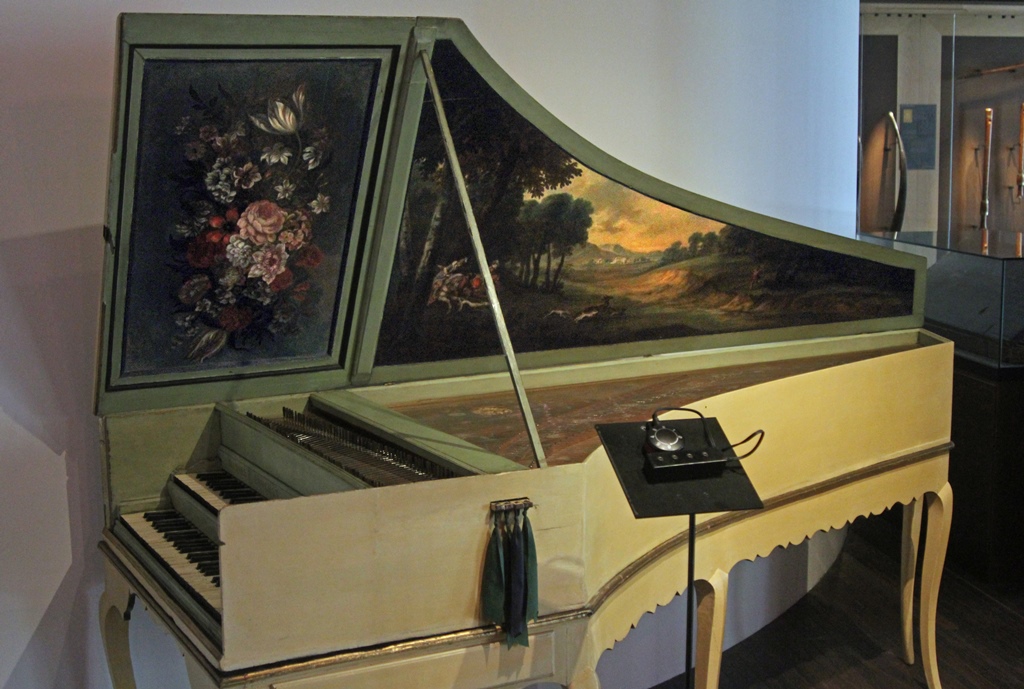
Couchet Harpsichord (Antwerp, 1646)
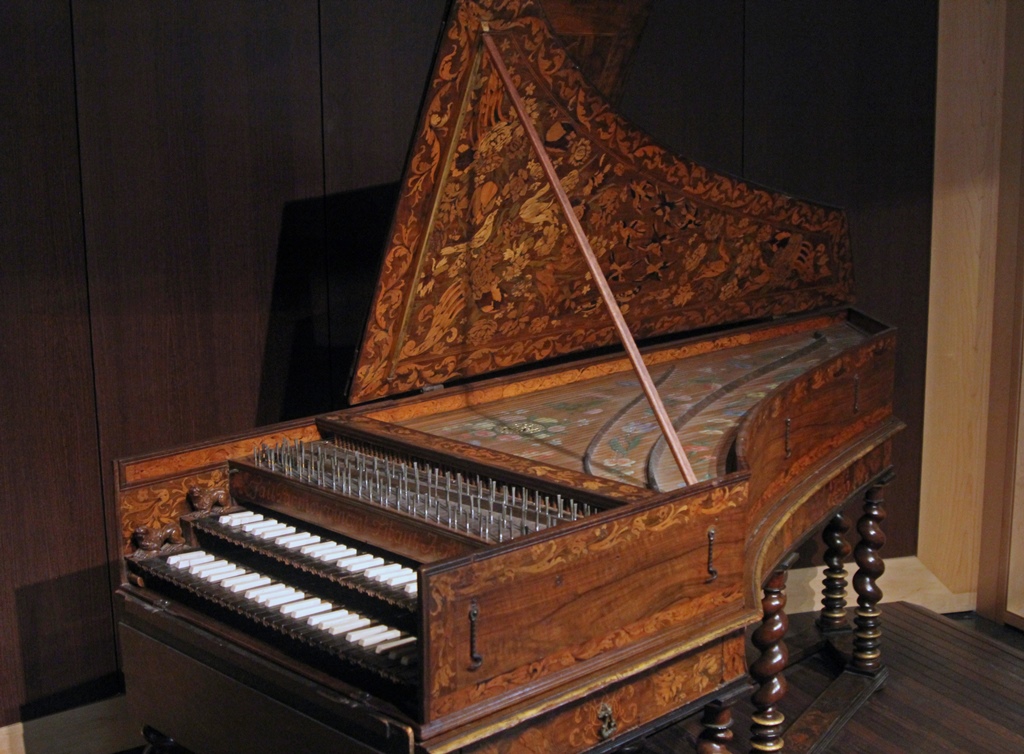
Harpsichord (Toulouse, 1679)
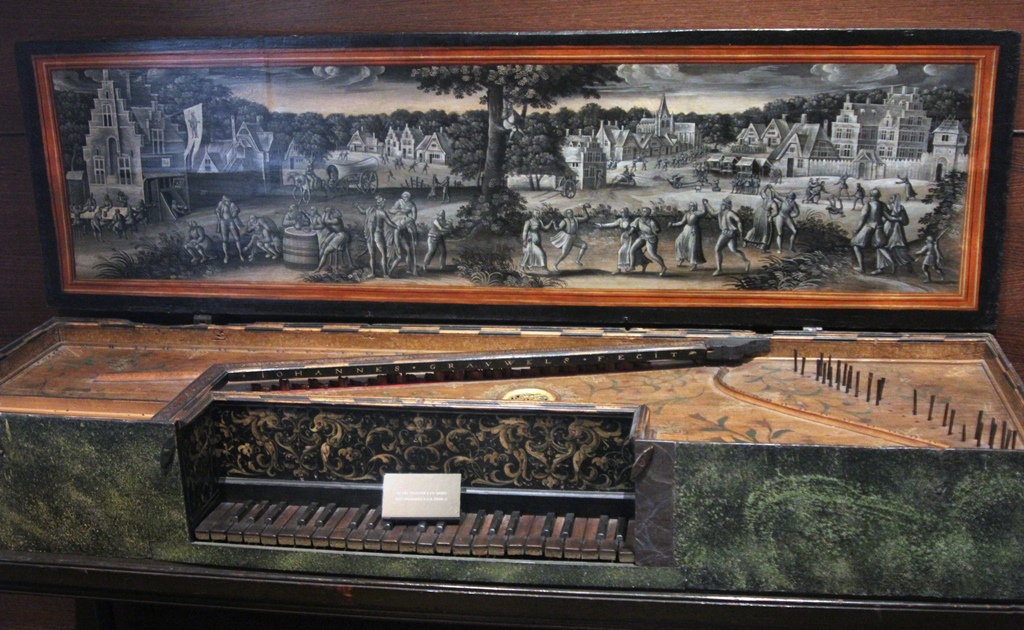
Rectangular Virginal (Antwerp, 1548)
Harpsichord/Virginal (Antwerp, 1619)
Again we came across an instrument that wasn’t quite what it seemed. In this
case the instrument looked like another harpsichord, but was instead a Spanish
instrument called a Geigenwerk. This instrument is played by two people – the
one playing the keys, and another one who furiously turns a crank to keep wheels
inside the instrument spinning. When the keys are pressed, the strings inside
the instrument are brought into contact with the spinning wheels, resulting in
a violin-like "bowing" sound.
Geigenwerk (Spain, 1625)
There were other beautiful keyboard instruments as well, mainly pianos.
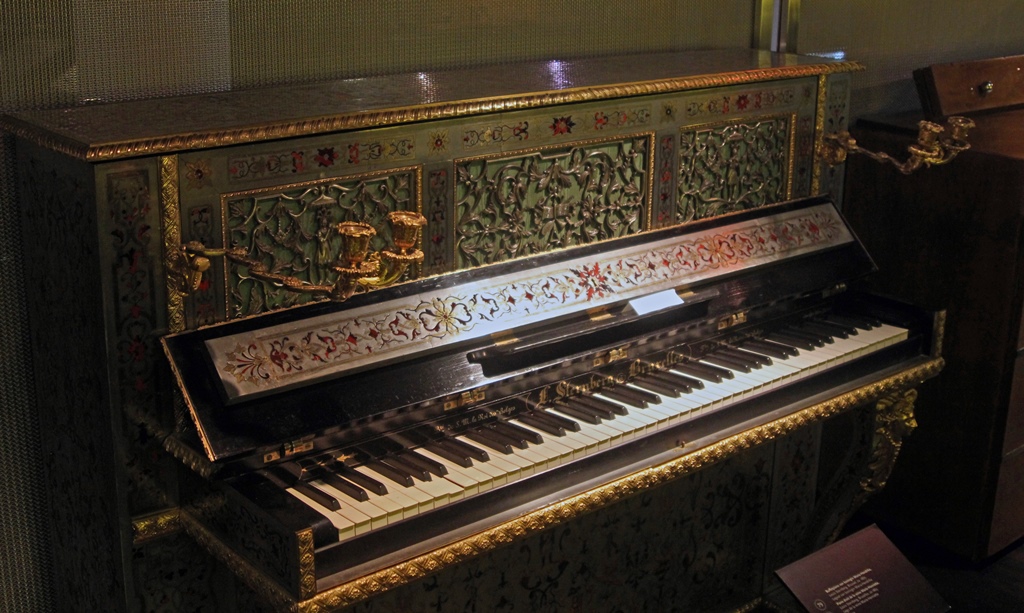
Piano of Queen Marie-Henriette (ca. 1865)
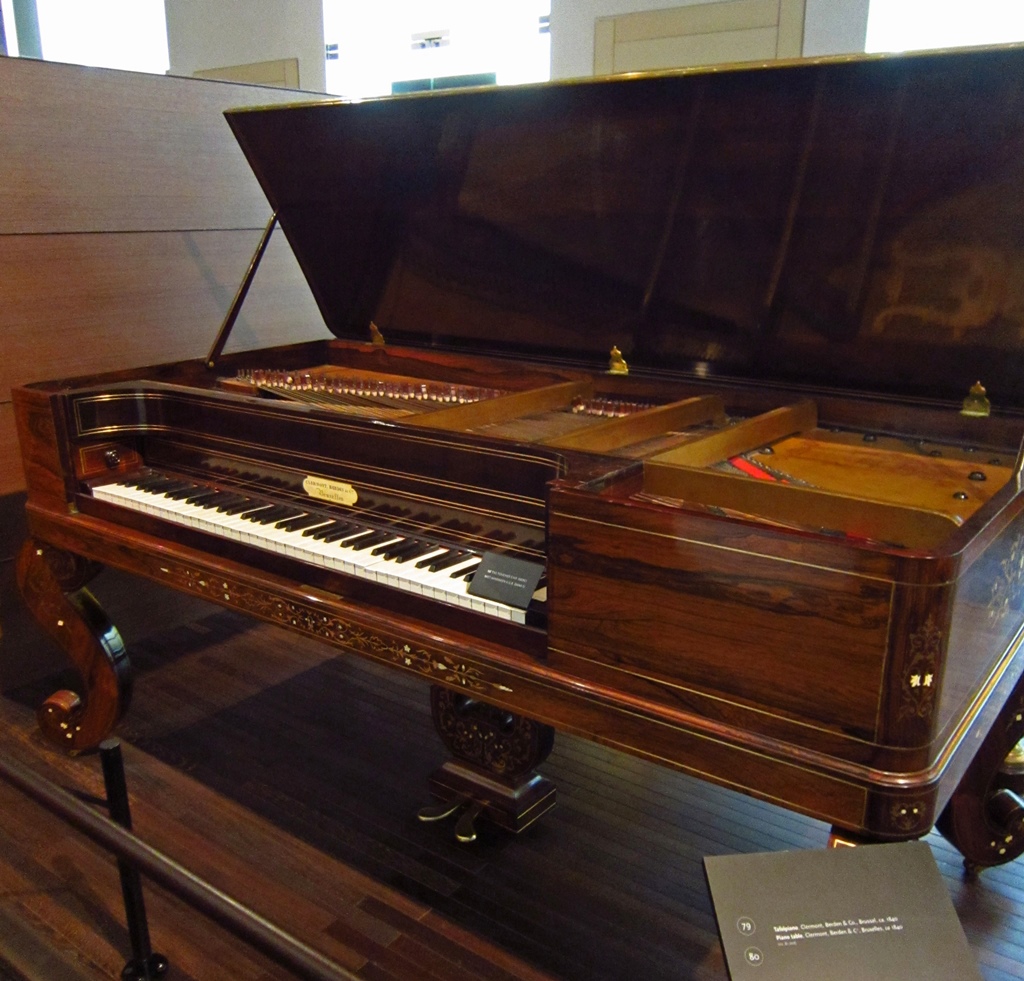
Piano (Brussels, 1840)
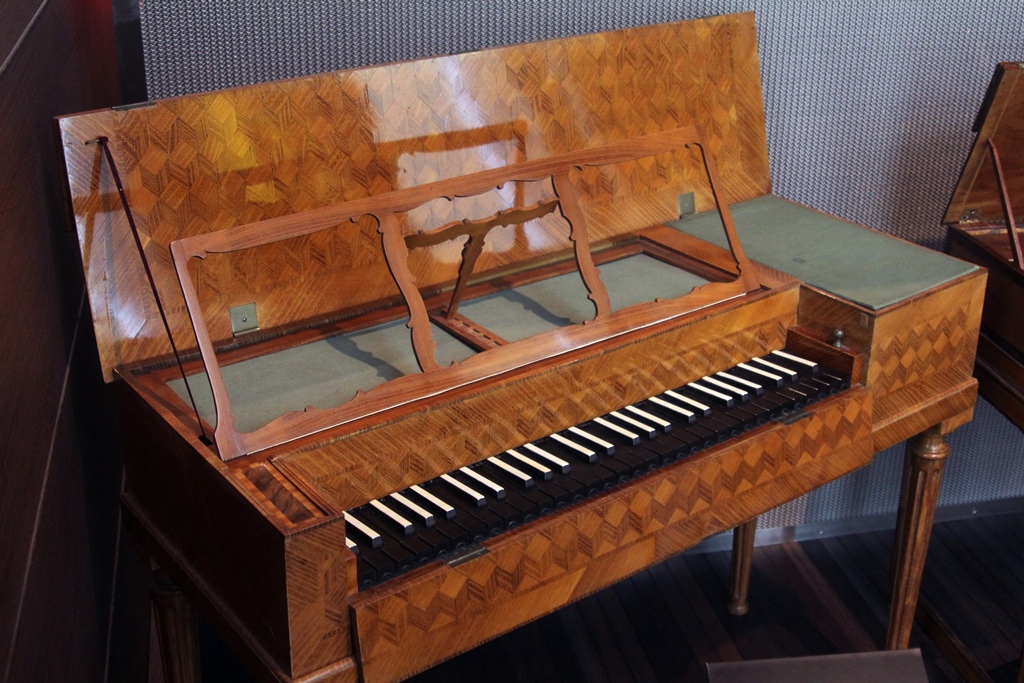
Piano (Dresden, 1793)
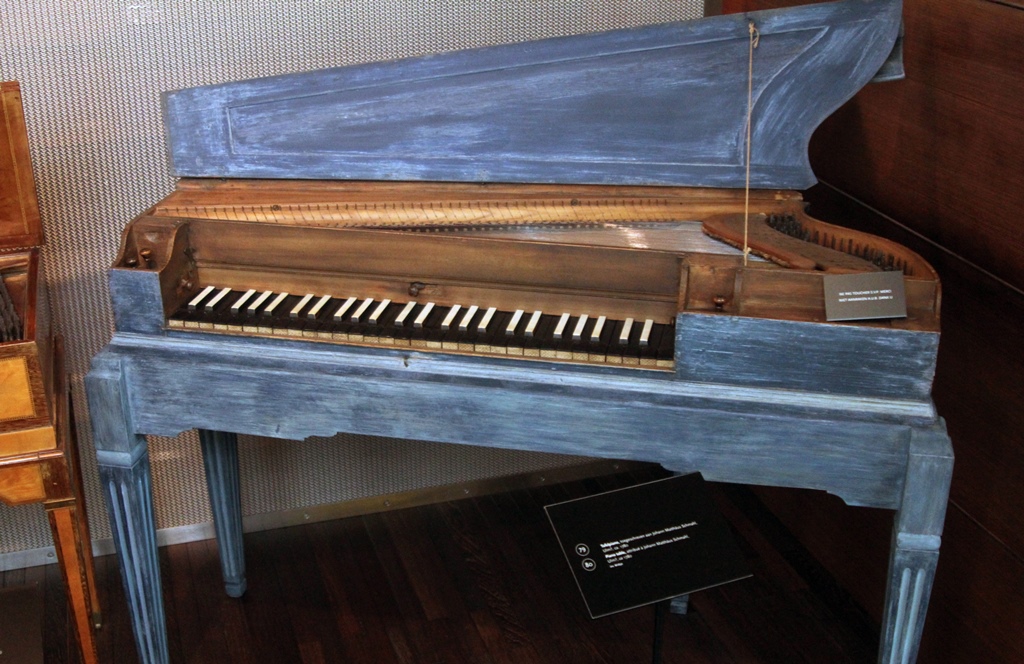
Piano (Ulm, 1780)
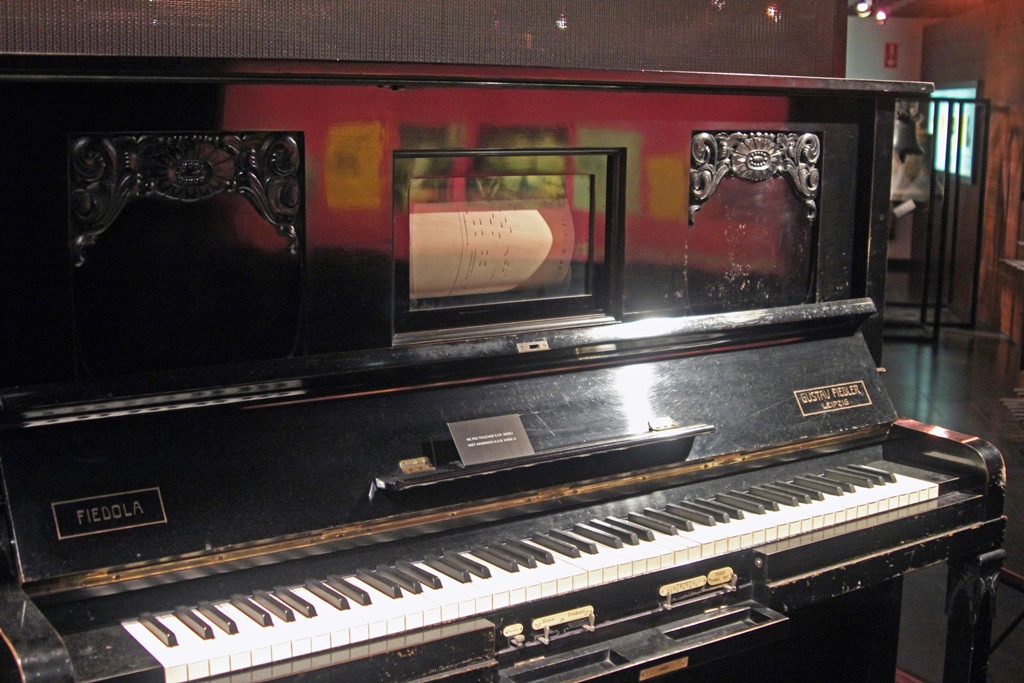
Player Piano (Germany, ca. 1900)
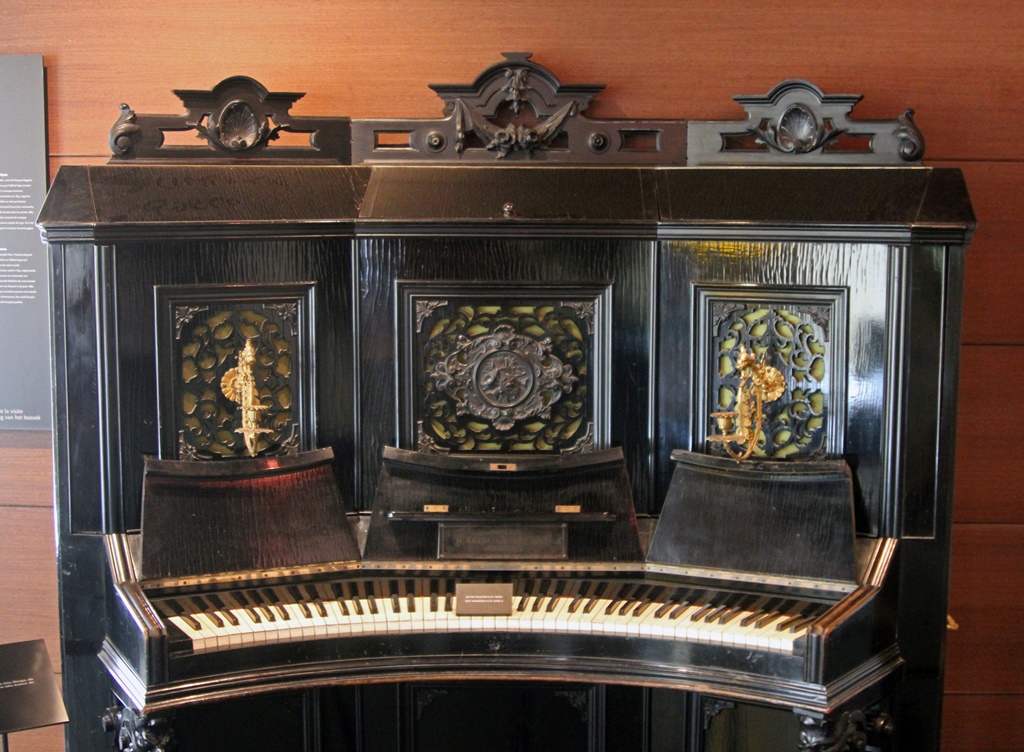
Wrap-Around Piano
Organ (Italy, 17th C.)
One piano had its top open to display an unusually complicated interior. This
is the only piano in the world that contains a functioning "luthéal" mechanism. The
luthéal mechanism, patented in 1919, can be placed inside a grand piano and adjusted
to change the timbre of the piano’s sound,
making it sound like other instruments
such as a harpsichord or a harp. In this age of electronic instruments this might
not sound that impressive, but at the time it was an impressive feat, being
accomplished solely by mechanical means.
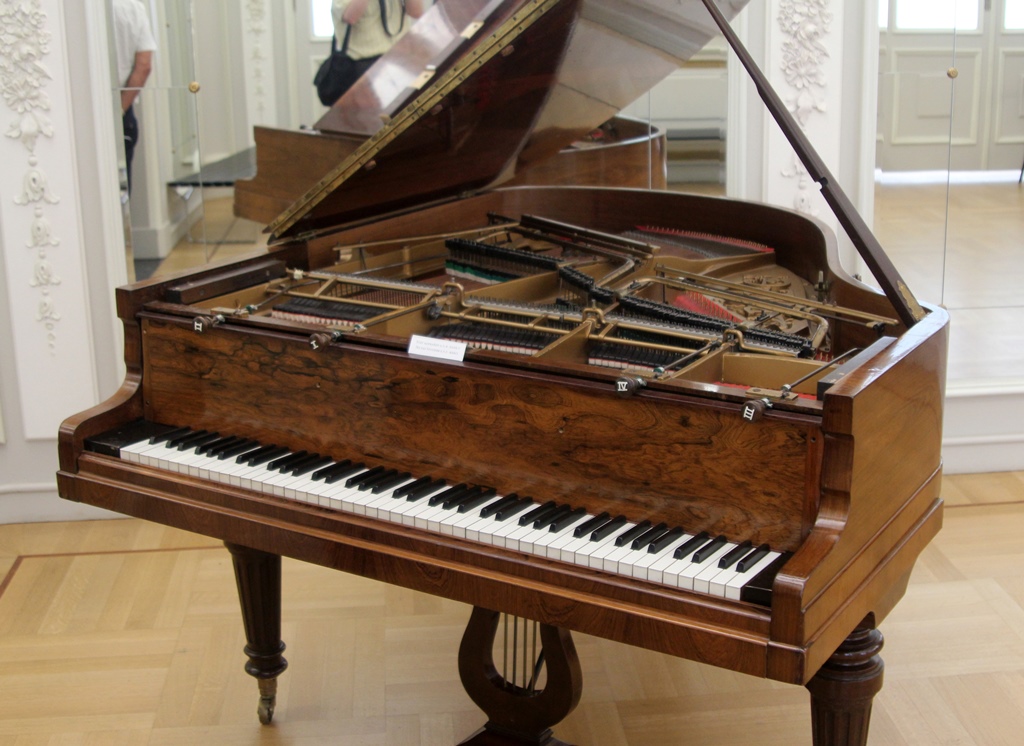
Pleyel Grand Piano (1911) with "Luthéal" Mechanism
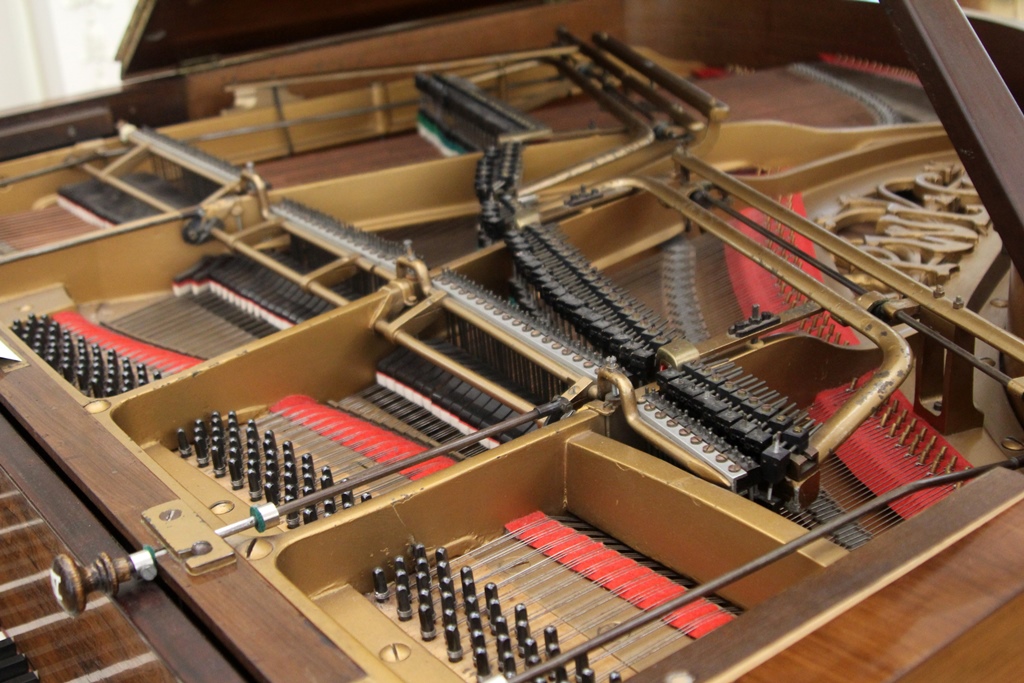
Innards of Piano with Luthéal Mechanism
Another piano caught our attention because it had two full keyboards. As it
turns out, the top keyboard is reversed, with low notes on the right and high
notes on the left. The idea was that a musician could play both high and low
notes with the same hand, making certain types of performances easier (if one
could get past the learning curve of mastering a backwards keyboard). Also,
it was possible to get more fingers on high notes or low notes at the same time, yielding
a sound density
usually only available in duets. Again, this is the only one of these in the world.
Double Piano with Mirrored Keyboards (Paris, 1878)
Finally, an instrument known as a "glass harmonica" was on display. This instrument
consists of a set of nested glass bowls, mounted on their side in a wooden cabinet
and free to spin like a lathe (through use of a foot pedal). Those who have run wet
fingers along the rim of a crystal wine glass can imagine the type of sound that is
produced by applying wet fingers to a glass harmonica. Multiple notes can be played
at once, depending on the number of fingers applied. After the instrument was introduced
in the late 18th Century, it was popular for a time, until people decided that it could
cause epileptic seizures. You can hear
a short selection
for yourself on the museum website if you’re so inclined, but don’t say you weren’t warned.
"Glass Harmonica" (Germany, late 18th C.)
After looking at the instruments, we went upstairs, past a small concert hall
to the bar at the top of the building. We weren’t thirsty, but we were
interested in the view of the Lower Town.
Lower Town from Bar
This completed our visit to the Musical Instruments Museum, and we headed back
down the hill to the Lower Town. On the way we passed an interesting looking
clock, to the right of the Albertina Park, known as the Clock of Citizens. This
clock is a Jacquemart clock, meaning there’s a figure at the top that strikes a
bell, and there are twelve other figures mounted in the wall around the clock face,
each pointed to by an hour. The clock was built in 1959 for the Brussels
World’s Fair.
Jacquemart Clock
We returned to the hotel and relaxed for awhile, eventually going out and
getting some dinner. We returned to the hotel by way of the chocolate
store installed in its ground level.
Chocopolis
We tried some of the chocolate but weren’t that impressed. Maybe we selected
poorly. We resolved to resume our quest for Belgian chocolate later. If we
were to find it the next day, we’d have to find it in another city, though,
as we were planning to take a trip to the city of Bruges.















